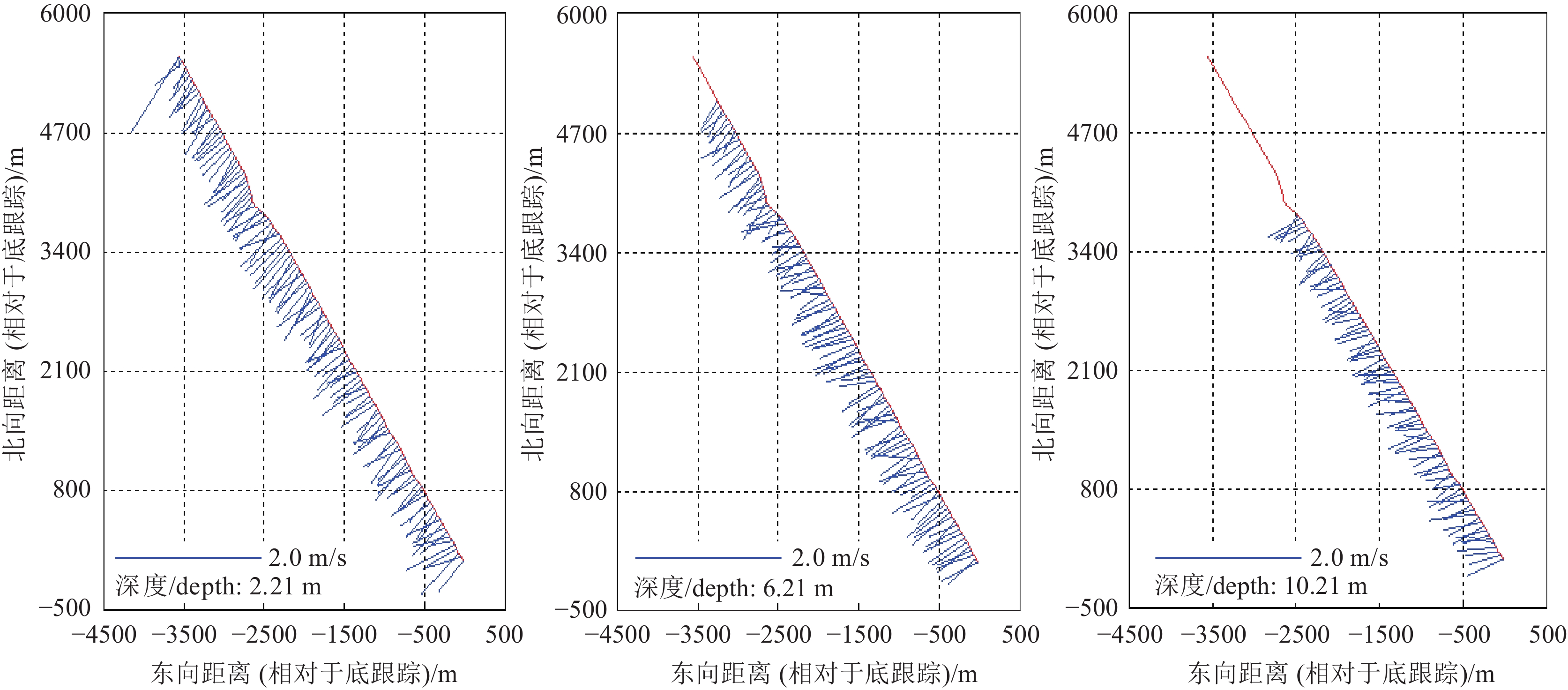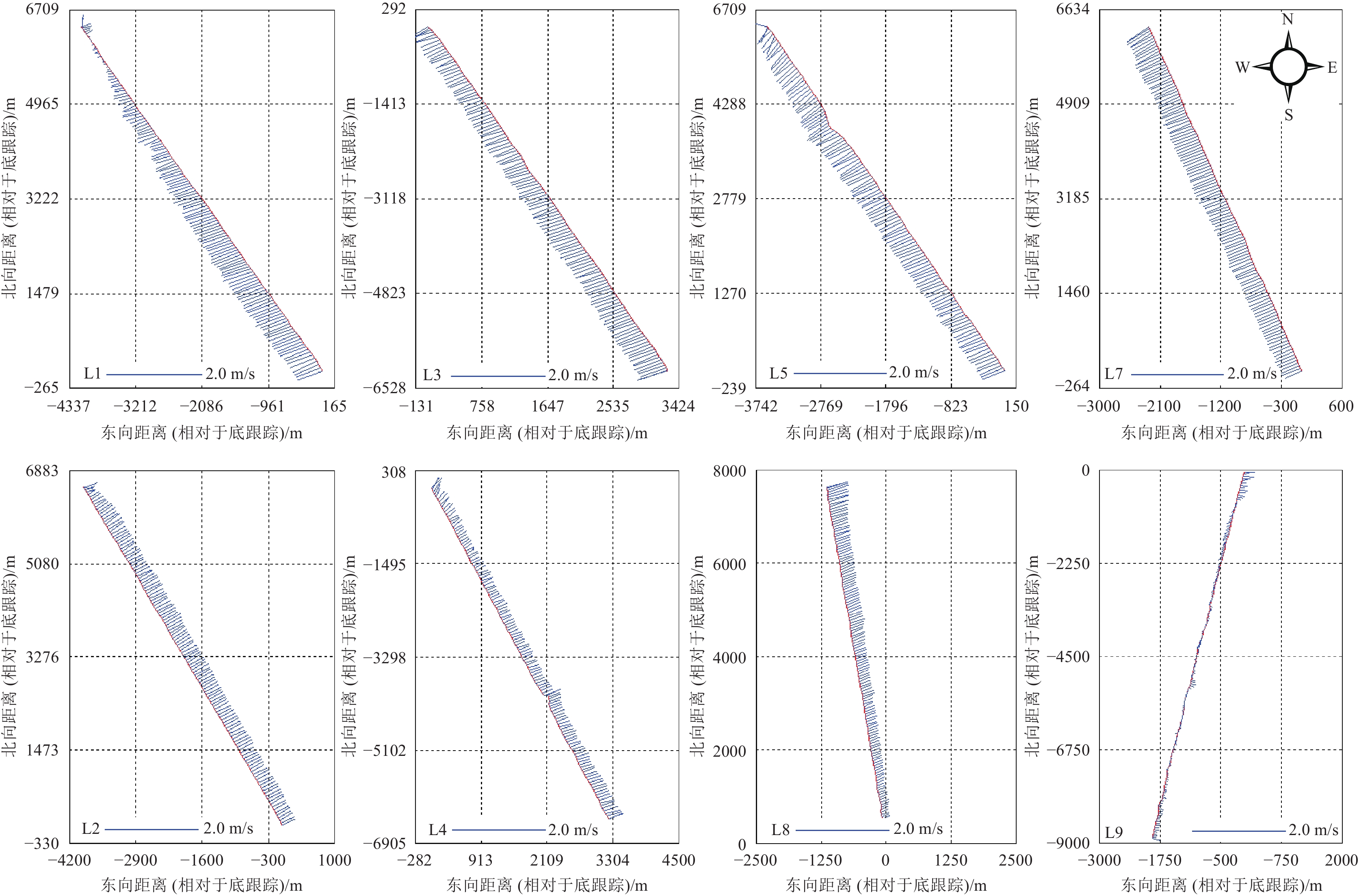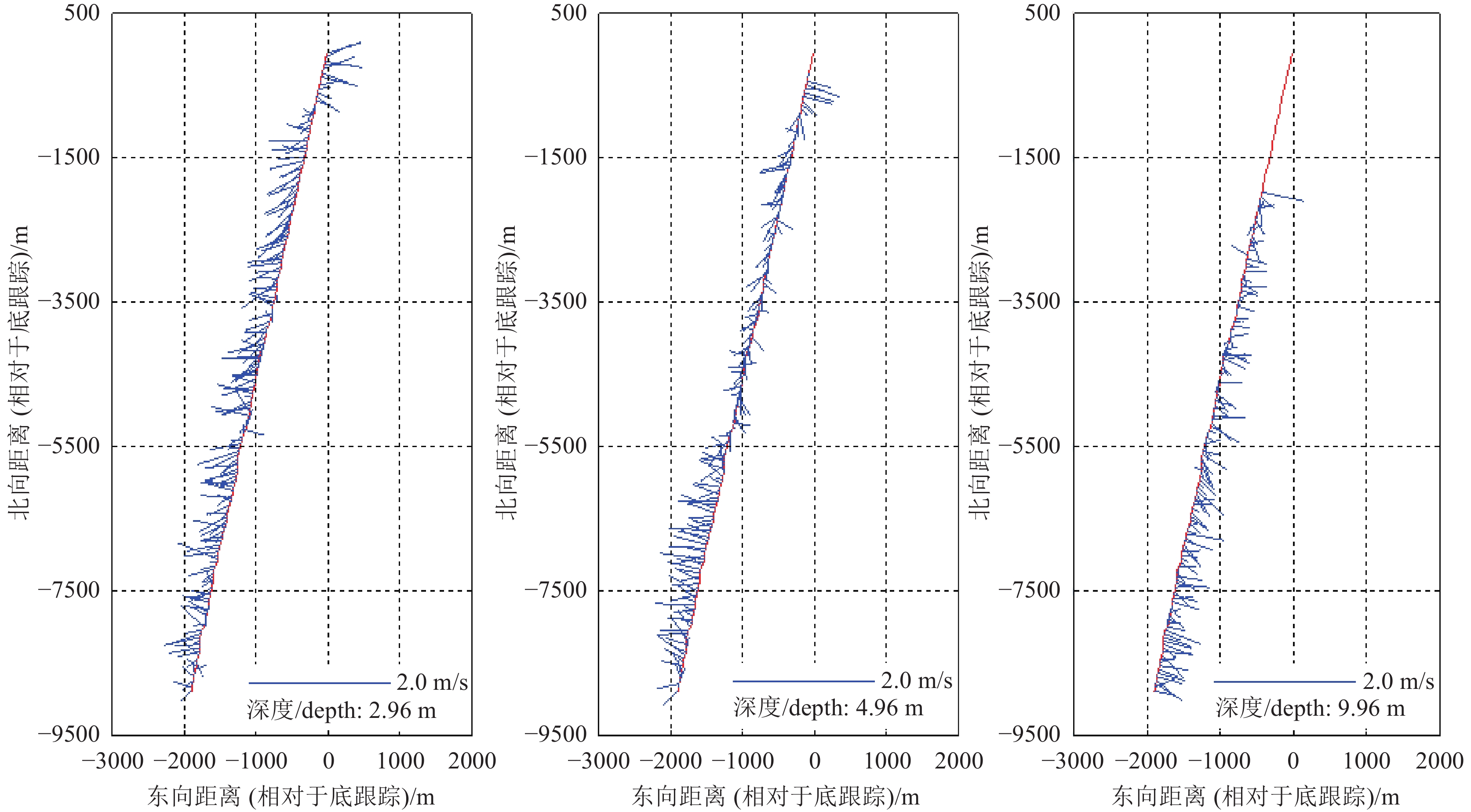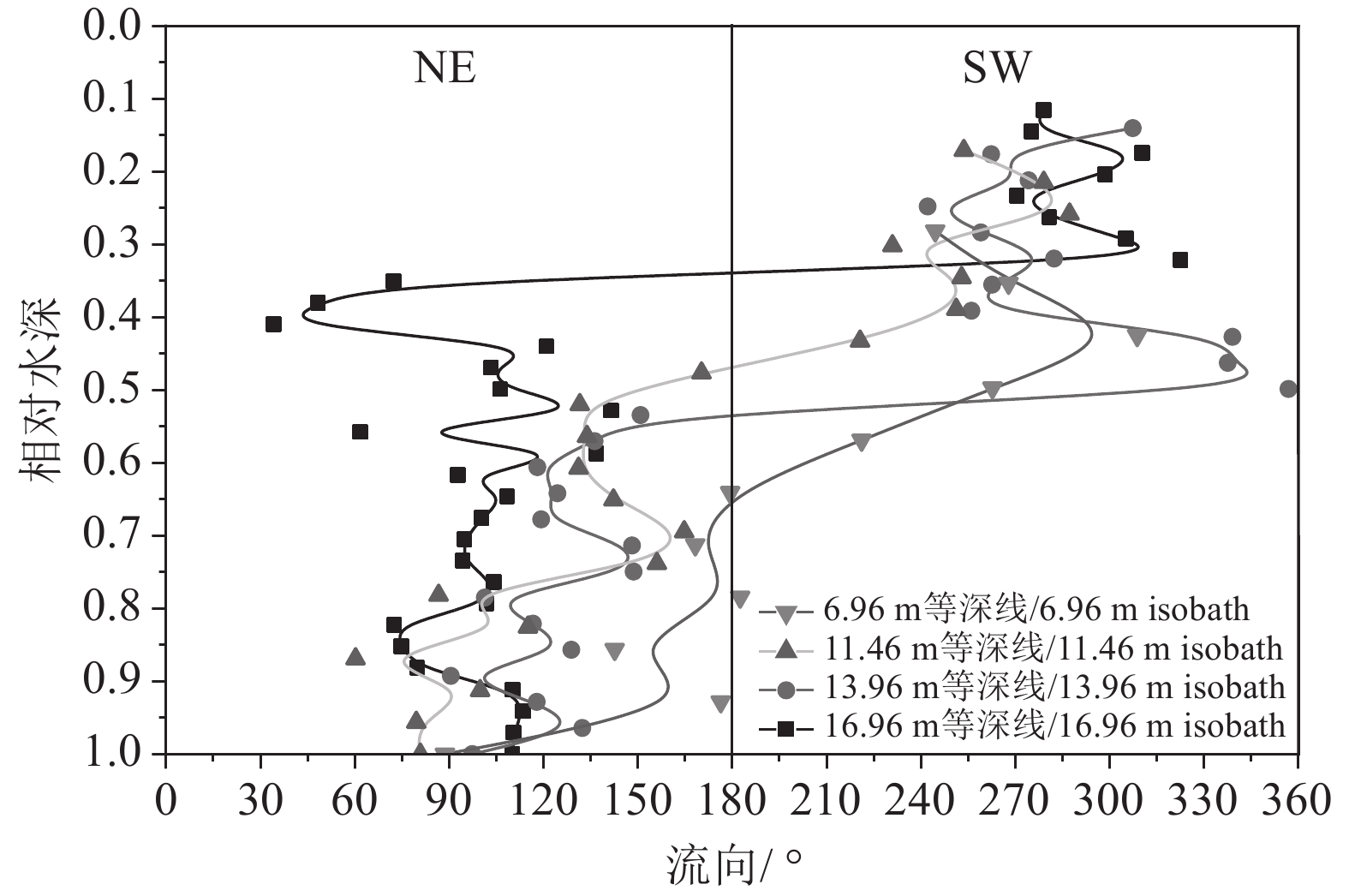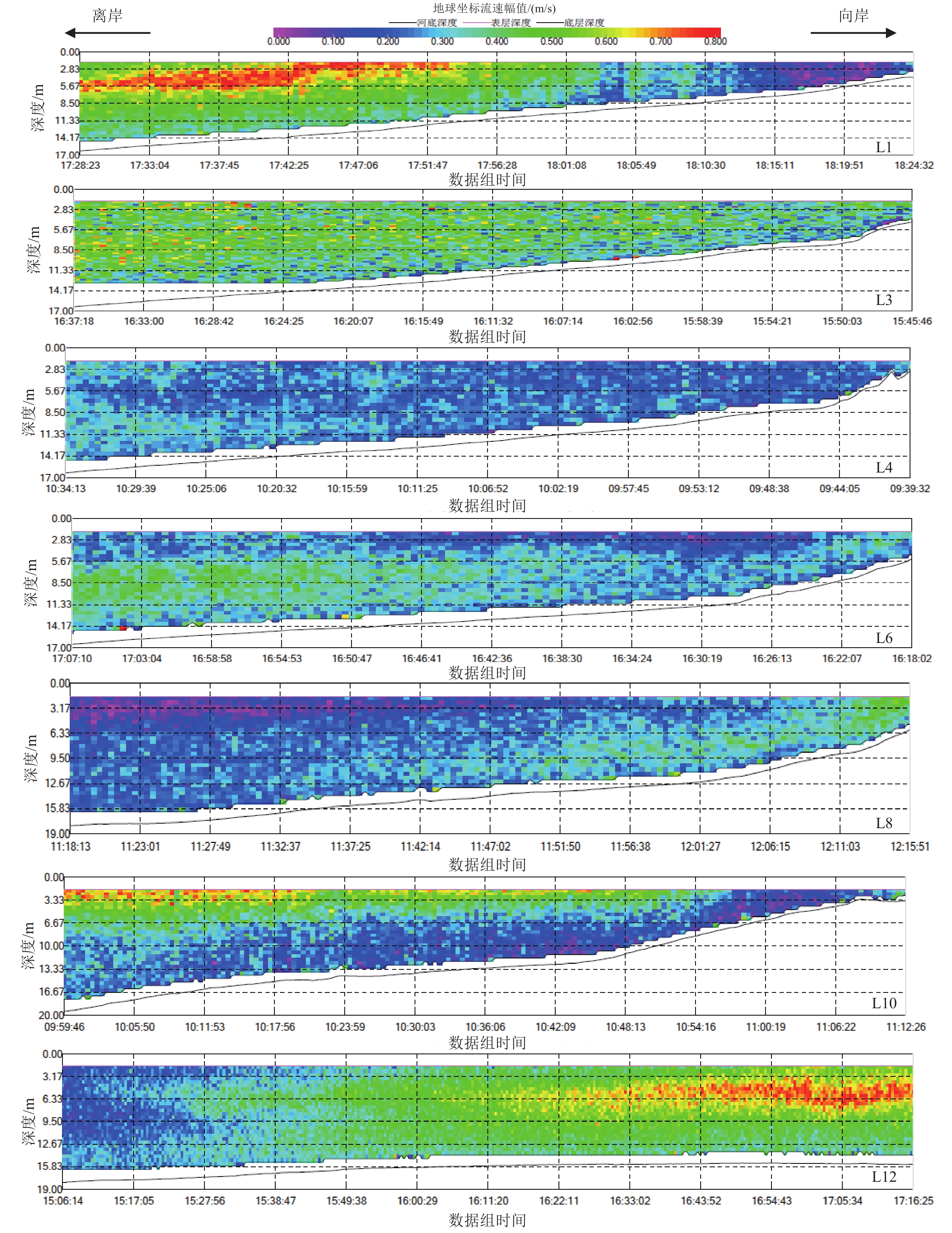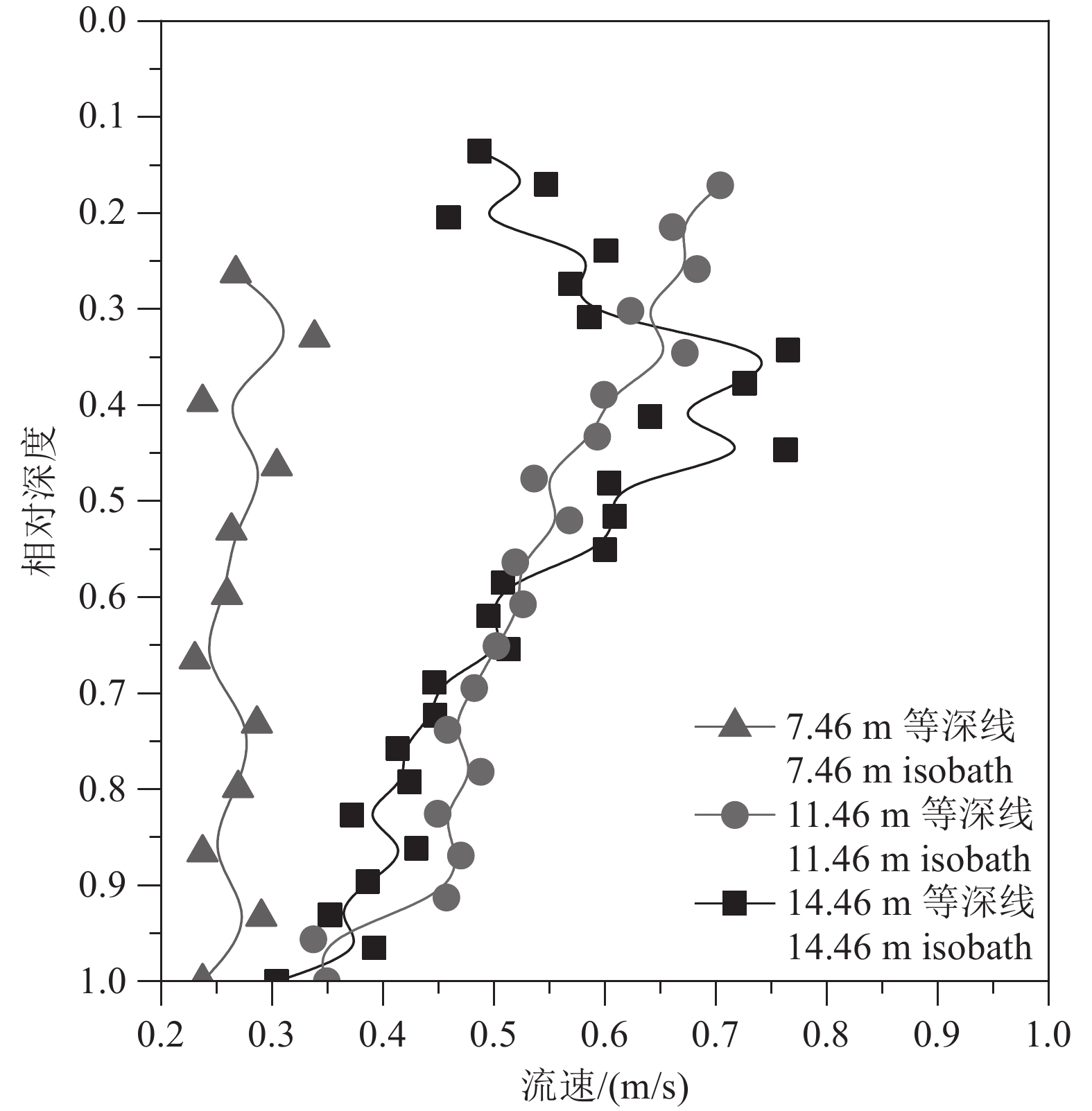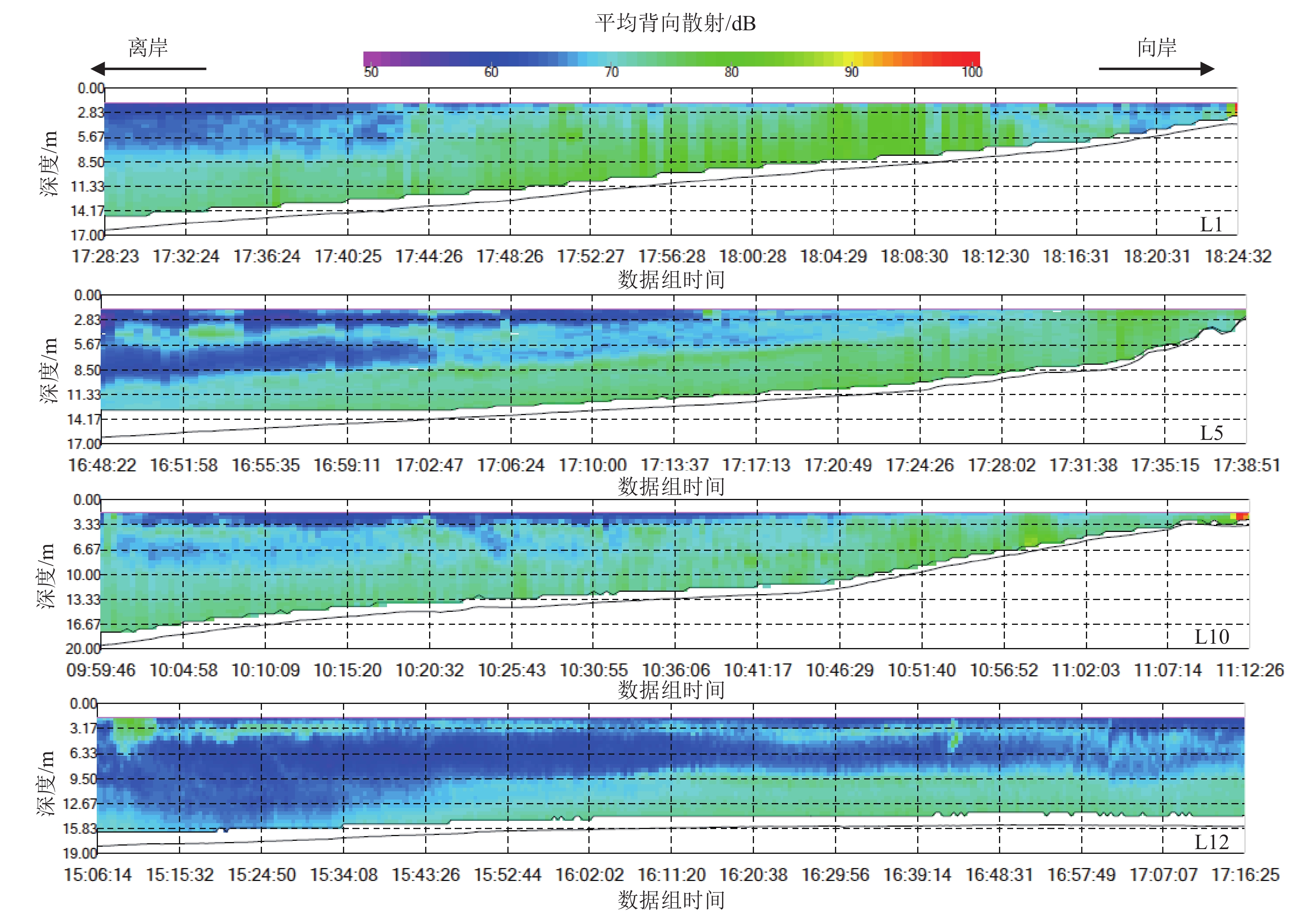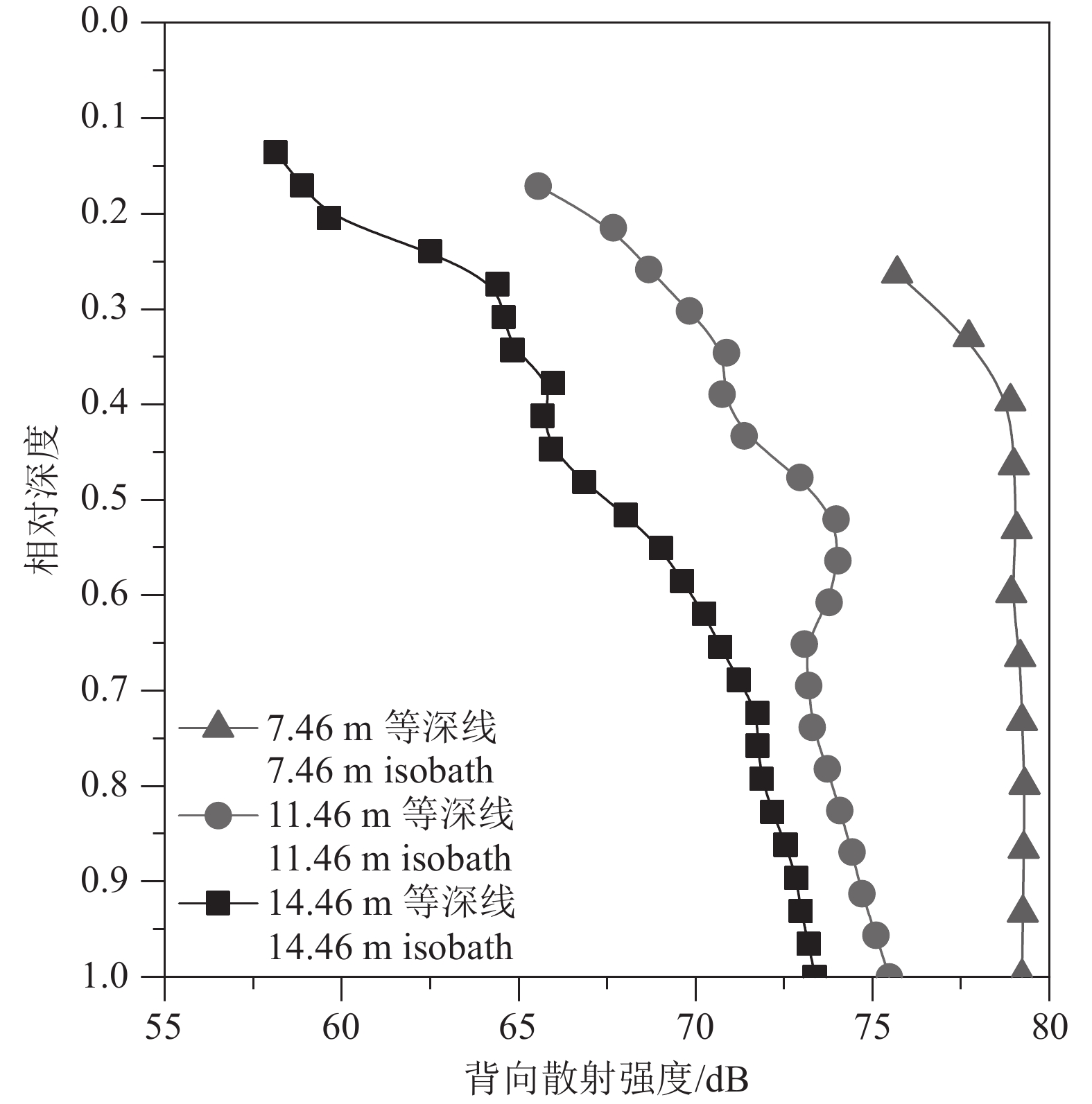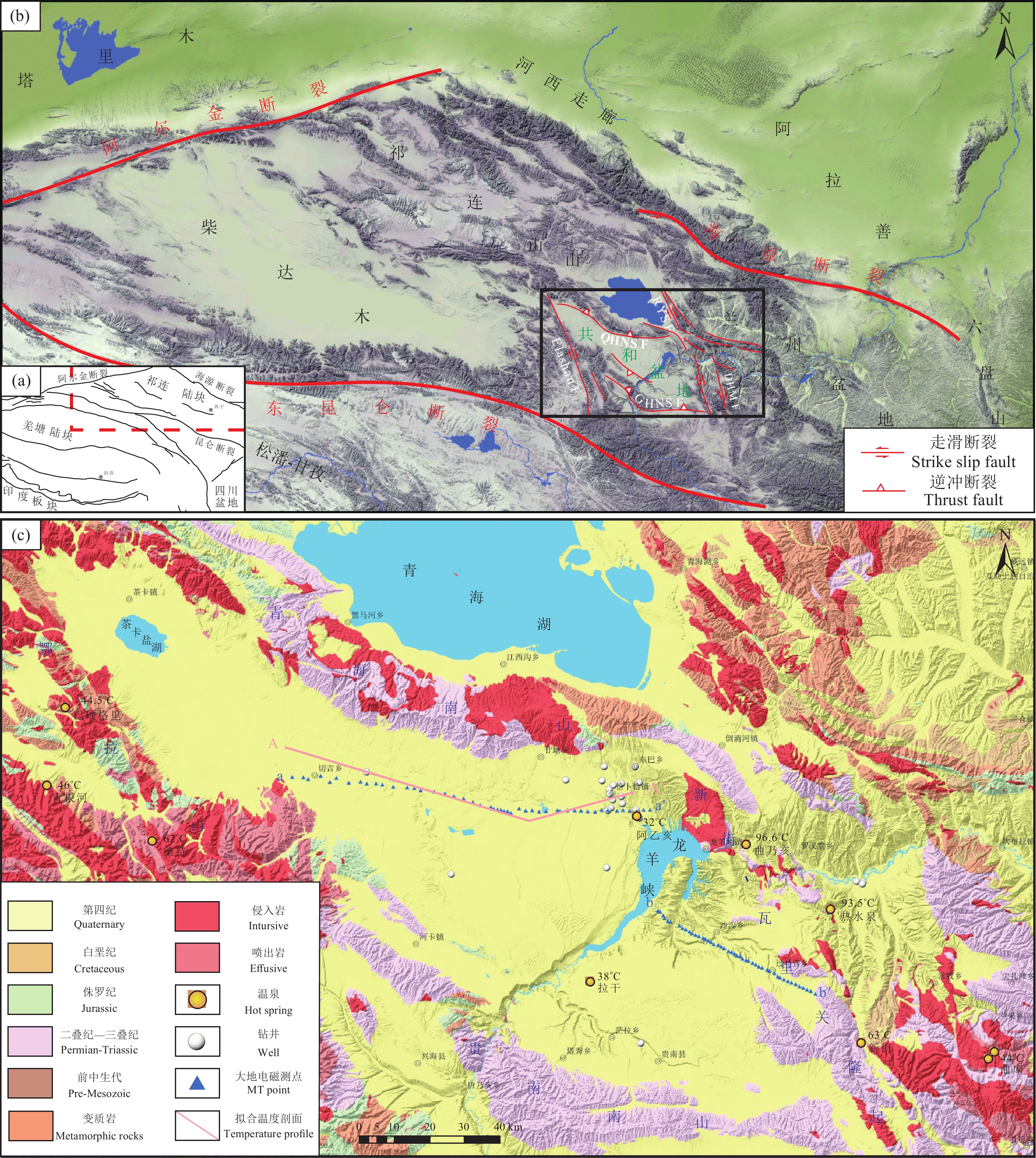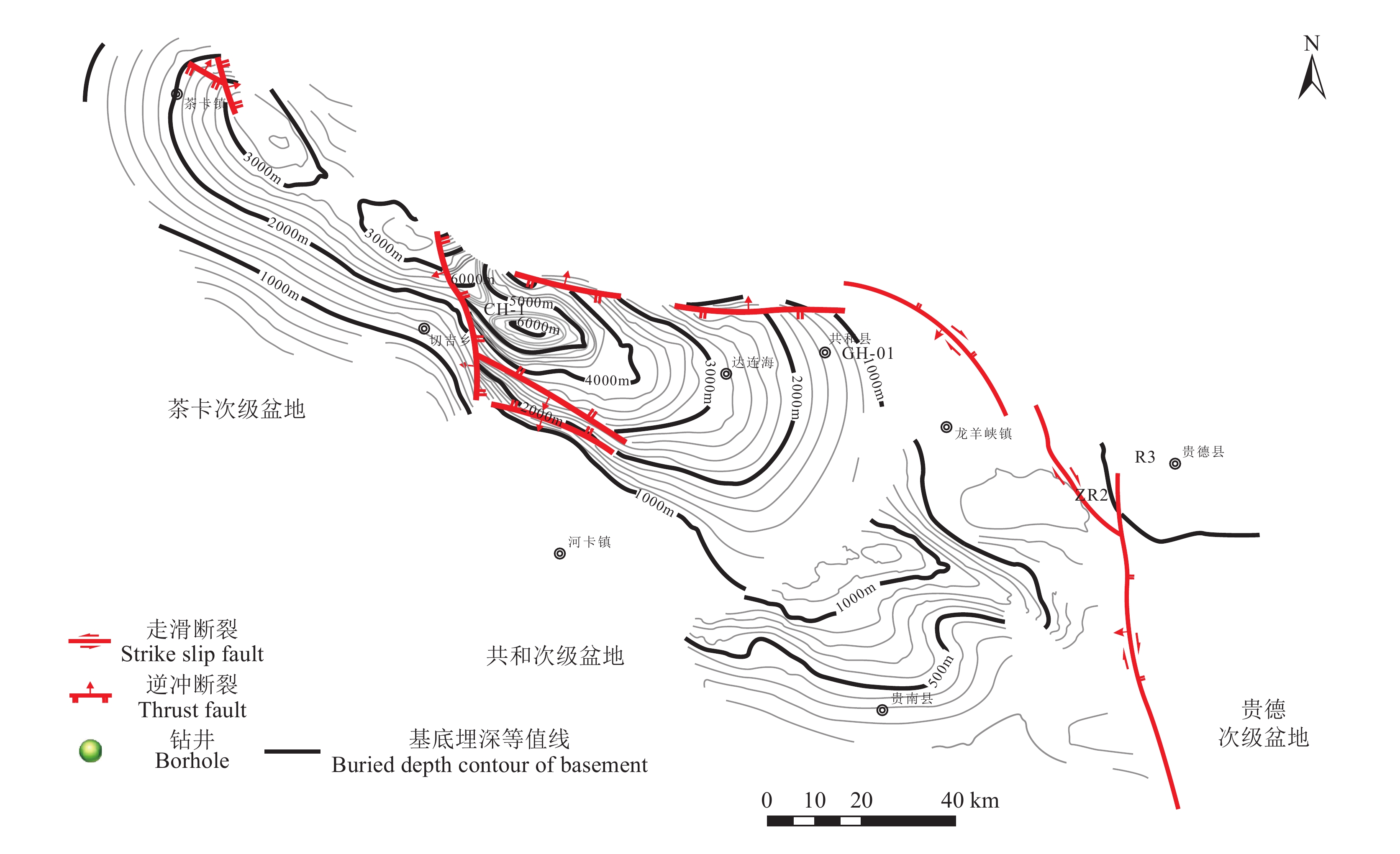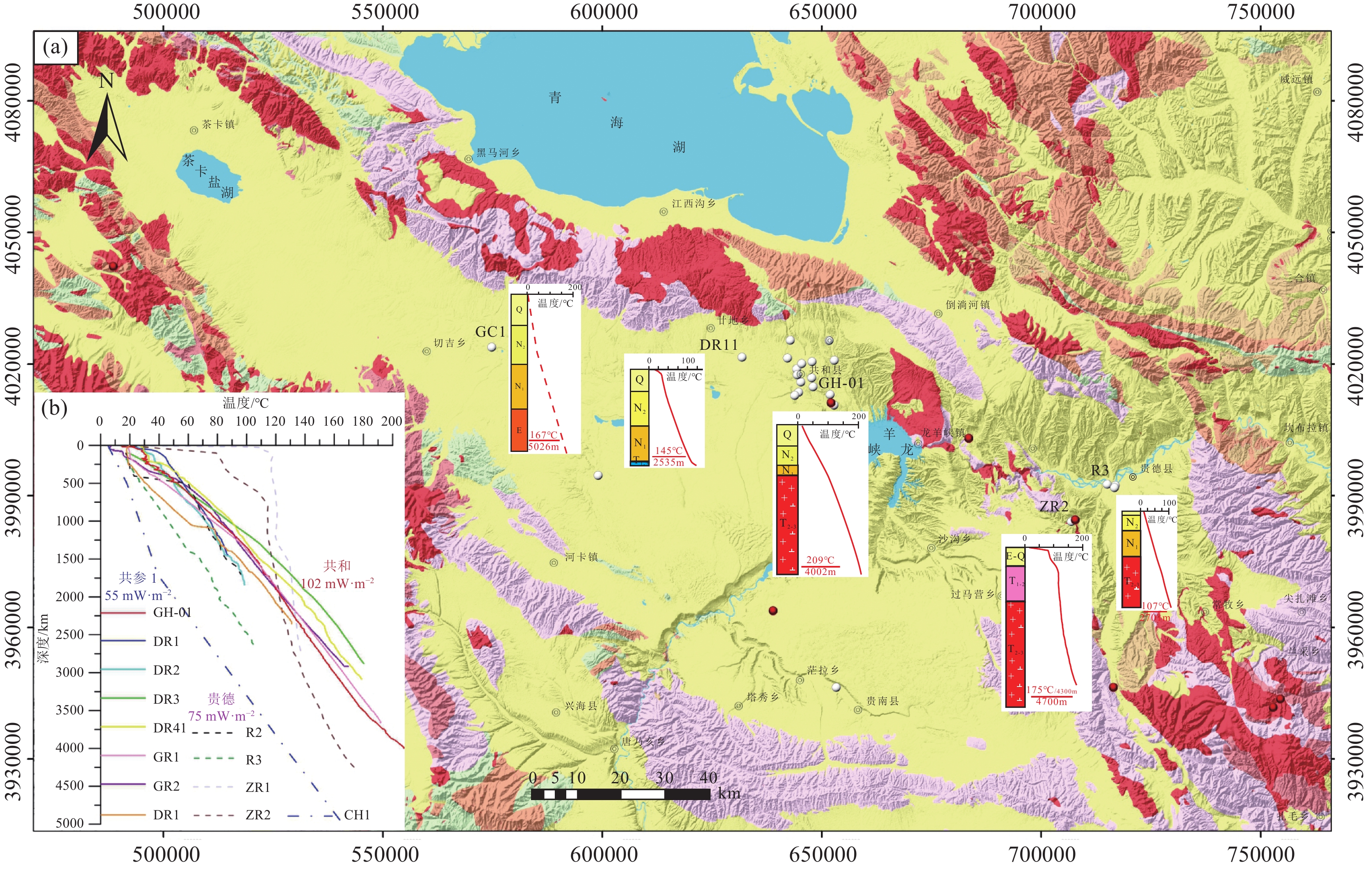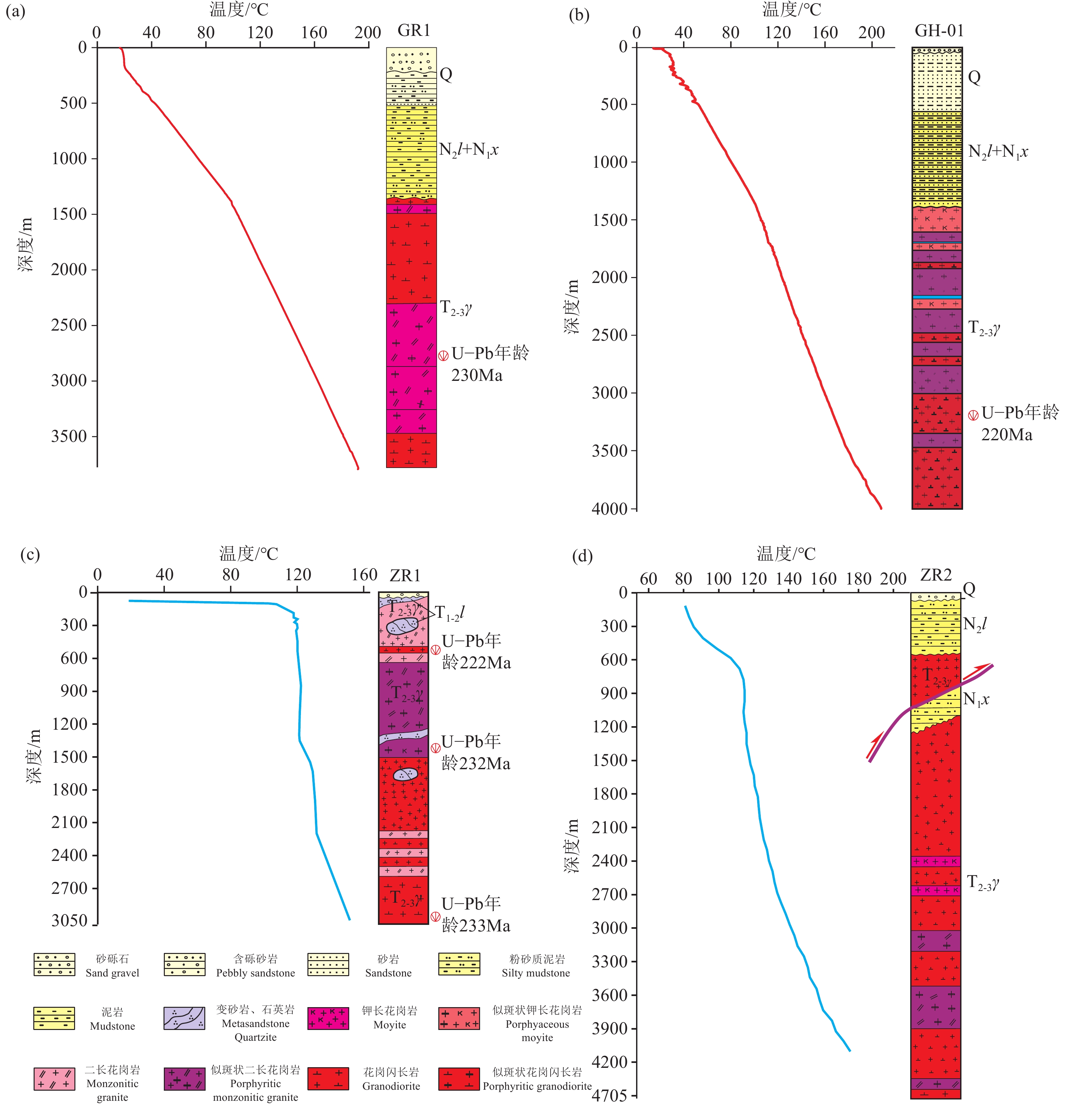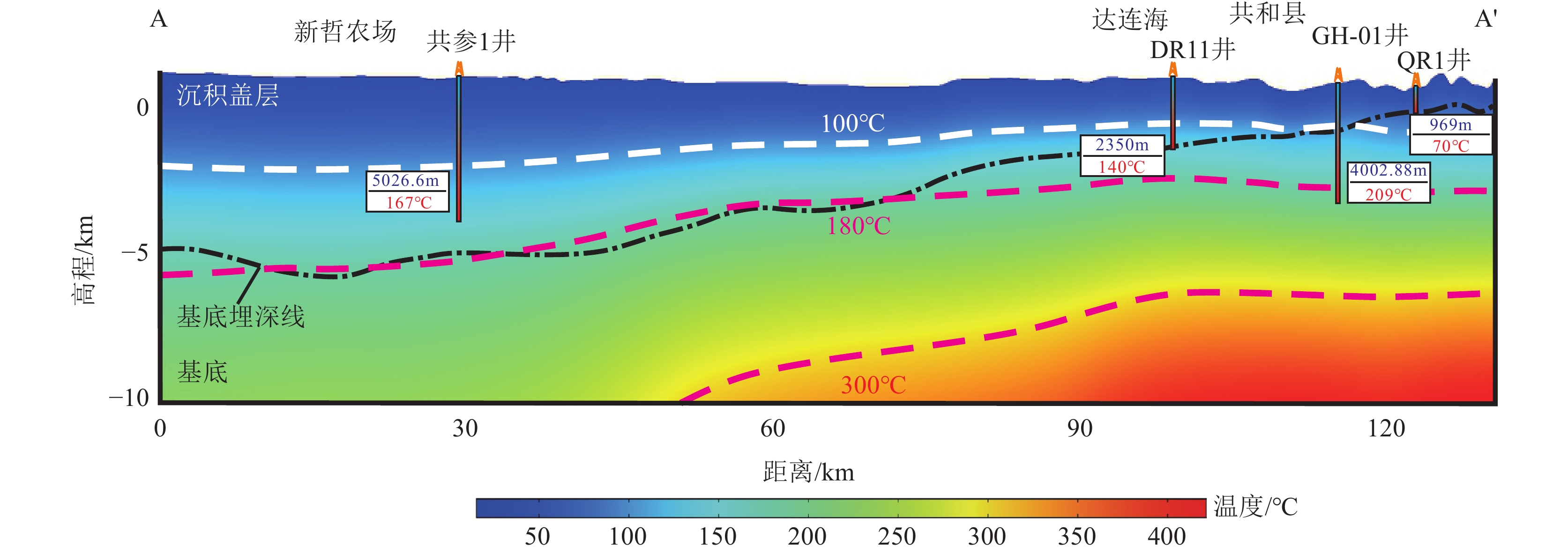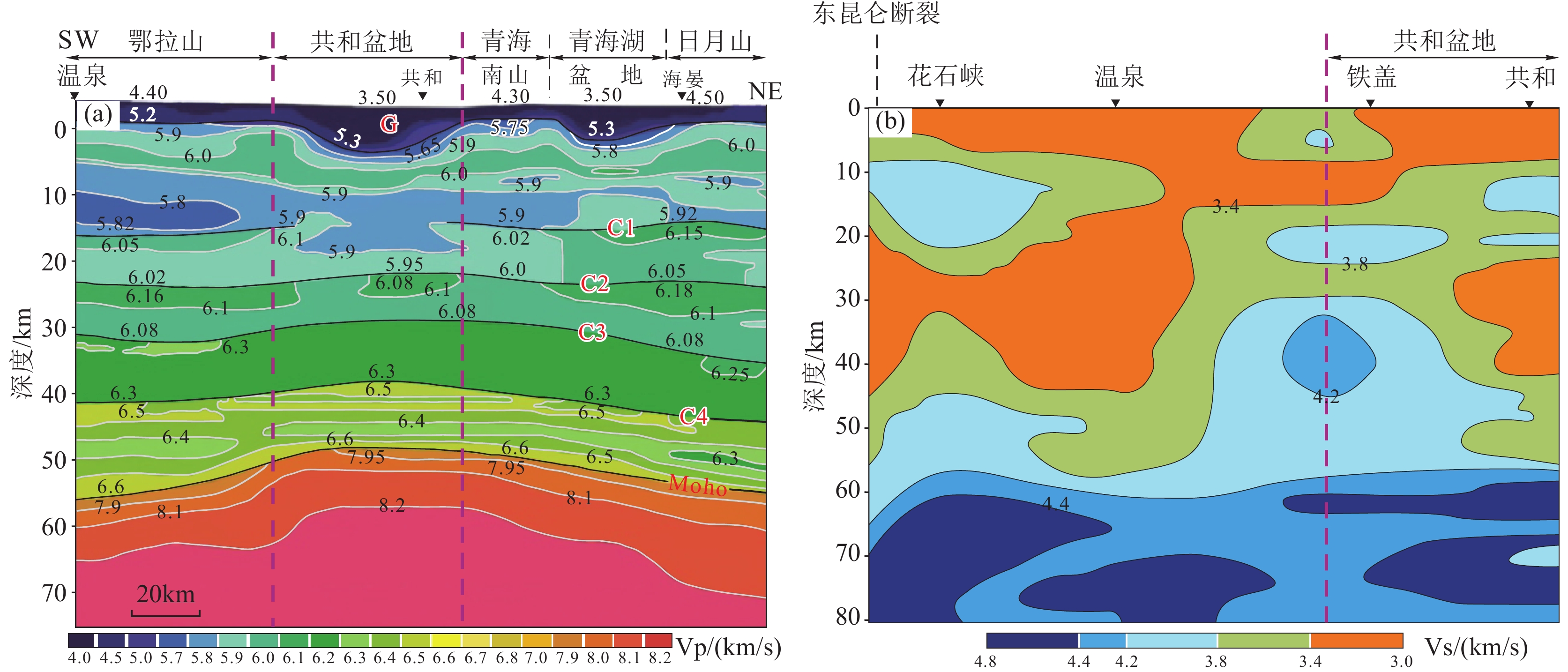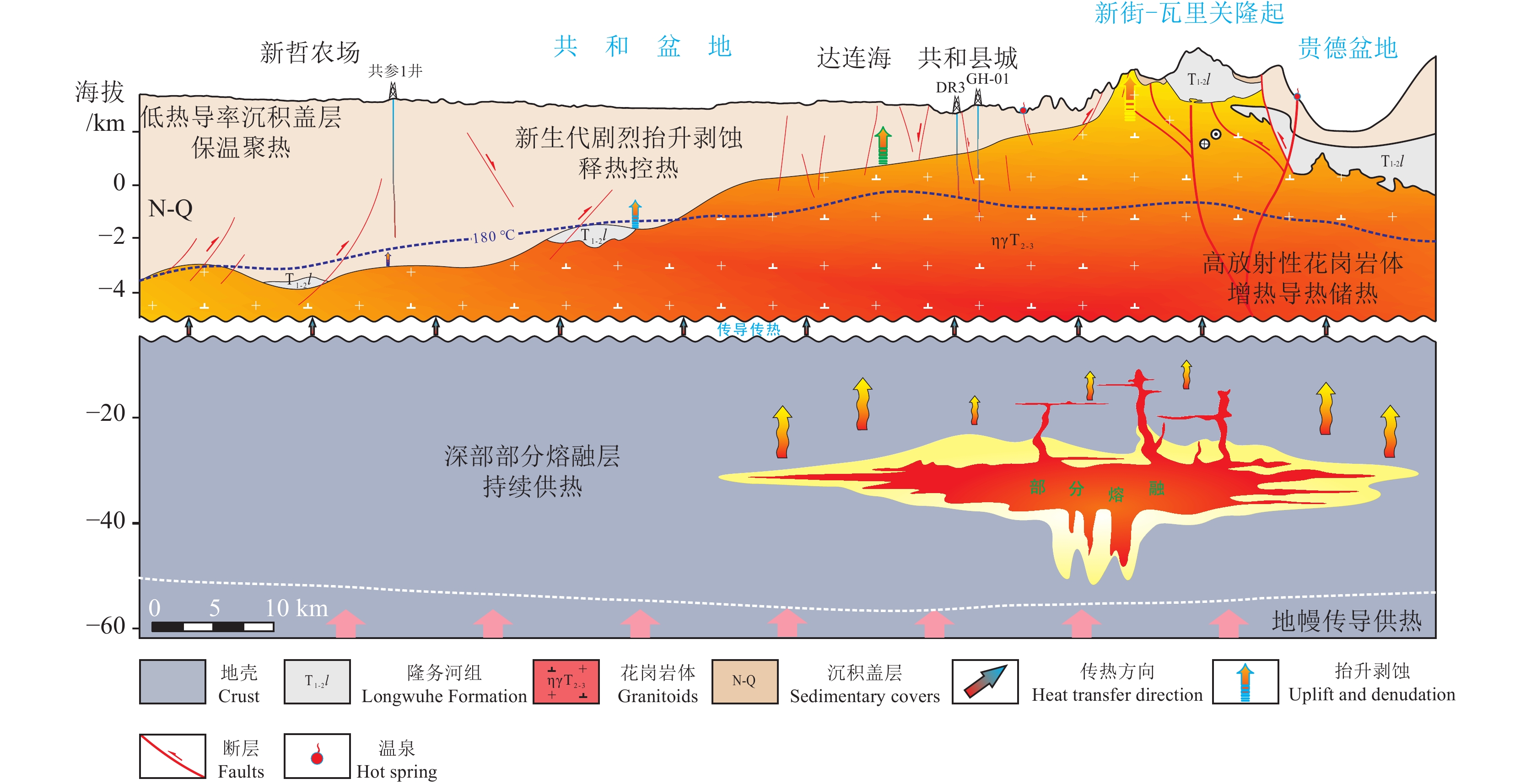Geothermal geological characteristics, genetic model and resource potential of hot dry rocks in Gonghe Basin, Qinghai Province
-
摘要:研究目的
位于青藏高原东北缘的共和盆地干热岩体是近年来我国内陆地区深层高温地热探测的重要发现之一,其成因机制一直备受争议,是研究的热点内容。现今热状态是盆地地热地质研究的重要内容,对深入理解高温地热分布规律及成藏机理具有重要的意义。
研究方法本文基于地球物理探测和钻井测温资料,分析了共和盆地基底结构特征与高温地热分布规律。采用数值模拟方法,初步获取了盆地近东西向二维温度场剖面,在此基础上,评估了干热岩资源潜力并对干热岩成藏要素进行了讨论。
研究结果共和盆地干热岩地热资源丰富,5 km以浅资源量估算为2.48×1021 J。盆地温度场东西向存在显著差异,变化规律与盆地基底埋深起伏特征相类似,盆地东北部新街—瓦里关隆起带周缘地区具有较好的地热地质条件。
结论在综合前人研究基础上,我们认为,共和盆地深部部分熔融持续供热,放射性花岗岩体增温导热,新构造抬升剥蚀释热控热,沉积盖层保温聚热多种因素的影响,共同导致了盆地现今东西向差异明显的温度场特征和干热岩体的成藏就位。
创新点:(1)结合二维地震勘探、钻井等资料,厘定了共和盆地基底埋深特征,采用数值模拟方法,获取了盆地近东西向浅部地壳二维温度场分布;(2)在系统研究共和盆地地热地质特征基础上,探讨了共和盆地高温地热成因机制,为共和盆地干热岩勘探提供了地质依据。
Abstract:This paper is the result of geothermal geological survey engineering.
ObjectiveThe Gonghe Basin, situated on the northeastern margin of the Qinghai−Tibet Plateau, is a significant experimental area for the exploration and development of hot dry rock (HDR) in China. The formation mechanisms of HDR within the Gonghe Basin remain controversial and have attracted considerable research attention. The current thermal state is of great significance for a deeper understanding the distribution patterns and formation mechanisms of high−temperature geothermal reservoirs.
MethodsIn this study, extensive geophysical exploration and drilling data are integrated to describe the geological and geothermal architecture of the Gonghe Basin. A two−dimensional temperature field profile across the east−west axis is established through numerical simulation. Based on these results, the resource potential of HDR is assessed, and the key factors controlling HDR formation are analyzed.
ResultsThe Gonghe Basin hosts abundant HDR resources, with an estimated 2.48×1021 J within the depth of 5 km. The two−dimensional numerical simulation reveals significant temperature field variations between the eastern and western parts of the basin. The temperature field variations are consistent with the distribution of the basin's basement depth, which decreases from west to east. High−temperature anomalies are observed in the northeastern region, particularly around the Xinjie−Waliguan uplift belt.
ConclusionsOn the basis of understanding the knowledge of predecessors, this paper proposes a comprehensive HDR formation mechanism from the perspectives of geological, geothermal, and geophysical backgrounds. The formation of HDR within the Gonghe Basin is controlled by multiple factors, including continuous heating by partial melting, heating and conducting heat by granite, heat controlling by neotectonic uplift and denudation, and heat preservation and accumulation by sedimentary covers.
Highlights:(1) The stratigraphic distribution within the Gonghe Basin was determined through the integration of 2D seismic, drilling and other exploration datasets , and the two−dimensional temperature field distribution of the shallow crust in the basin was established for the first time by numerical simulation; (2) Based on the systematic study of geothermal geological characteristics of the Gonghe Basin, a genetic mechanism for the high−temperature geothermal resources within the basin was proposed. This mechanism provides a fundamental geological basis for the exploration of hot dry rock (HDR) resources in the Gonghe Basin.
-
1. 引 言
流速、流向及悬浮沉积物浓度对海洋物理、生物、化学要素的循环具有重要影响,是研究浅海及河口地区泥沙输运、物质运移的基本要素。同步获取研究区全剖面的流速、流向及悬浮沉积物浓度对于理解悬浮沉积物输运过程、预测营养盐及污染物的迁移和归宿等问题具有重要的意义。传统的测流方法常采用单点式流速仪,对测点不同深度流速进行逐点测量以获得整个剖面的流速;悬浮沉积物浓度的测量常采用取样过滤称重法,该方法不但费时费力,而且在时间和空间的分辨率有限。
声学技术在海洋观测领域的发展应用,使得海洋水文要素的测量有了质的改变,声学多普勒剖面流速仪(Acoustic Doppler Current Profiler,ADCP),能够快速获得某个完整剖面的流速、流向等参数,同时仪器同步记录的声学背向散射强度可间接计算所测海域悬浮沉积物浓度的分布情况,为海洋泥沙动力输运的研究提供可靠的数据支撑。声学法具有不采样、水体不受扰动、精度高等特点,已被广泛应用于海洋水文要素测量中(Simpson, 2001; Yorke and Oberg, 2002; Ha and Maa, 2008; Salehi and Strom, 2011;张英豪和赖锡军, 2014; Li et al., 2019)。船载走航式ADCP是指将ADCP搭载在调查船上,结合精准的导航系统,在船只走航过程中对所测海域的海流进行连续全剖面测量,具有不扰动流场、测量历时短、测量范围大、充分利用航时等特点,已被广泛应用到江河湖海的流速、流量测量中。如1997 年三峡工程大江截流和2002 年三峡工程明渠截流(杨丰和杨俊青,2004),以及广东北江飞来峡工程截流等(刘勇胜和黄程鹏,2014),杭州湾跨海大桥、港珠澳大桥等工程也均使用ADCP 进行了流速测量(刘彦祥,2016)。
祥云岛位于乐亭县东南部,京唐港与北港之间的沿海地带,岸滩分布有优质天然细沙,是著名的沿海旅游沙岛。祥云岛外海7~15 m等深线海域建有海洋牧场,占海面积1333 hm2。近年来,祥云岛受人为活动及海洋水动力条件影响,沿岸不同区域均出现了不同程度的侵淤现象(陈文超等,2016;汪翡翠等,2021);与此同时,海洋牧场等近岸工程的建设带来的环境效应逐渐受到重视,如崔雷等(2017)通过耦合二维浅水水动力数值模型及物质输运数值模型,对京唐港填海工程中周边潮流场及悬浮沉积物运移进行模拟研究,并分析了对海域水质环境的影响。因此,对祥云岛海域流速、流向及悬浮沉积物浓度的快速同步调查,对祥云岛及其近海工程的生态环境具有重要意义。本文通过船载走航式ADCP在祥云岛海域进行现场海流、悬浮沉积物全剖面测量,为该海域海洋动力、泥沙输运及祥云岛岸线演化等海洋过程的研究提供支撑。
2. 现场调查
2.1 ADCP测流原理
ADCP基于多普勒原理(刘德铸,2010;张春海和董晓冰,2013),通过测定声波入射到海水中微颗粒背向散射在频率上的多普勒频移,从而得到不同水层水体的运动速度。所谓声学多普勒效应是指当物体相对于声源有径向位移时,导致观测到的声源发生改变的现象。多普勒频移与散射粒子速度之间的关系为:
Fd=2FVC 式中:Fd为声学多普勒频移;F为发射声波的频率;V为颗粒物沿声束方向的相对速度;C为声波在海水中的传播速度,式中“2”是因为ADCP发射并接收回波,所以多普勒频移加倍。假定水体中颗粒物的运动速度和水流速度一致,ADCP通过跟踪颗粒物的运动,测定水流相对于ADCP的速度,此速度扣除船速后,即可得到水流的绝对速度(杨锦坤等,2009)。
此外,由于散射ADCP发射波的颗粒物主要是悬浮沉积物,ADCP同步接收水中散射体的回波强度信号的大小能够间接反映水中悬浮沉积物浓度(杨惠丽等,2017)。利用ADCP背向散射强度反演悬浮沉积物含量是一种便捷,高效的方法,其非干扰式的测量特性更易获得真值。自Deines (1999)提出了声学多普勒剖面仪测得的背向散射强度与悬浮沉积物含量的关系后,许多学者也逐步开展了利用ADCP的背向散射强度反演悬浮沉积物含量的研究(Glenn et al., 1999; Hoitink, et al., 2005; Merckelbach et al., 2006; Gunawan et al., 2010)。已有研究表明源声波散射强度的大小与散射水体中的悬浮物浓度的大小成正比(Thorne and Campbell, 1992),在受潮流、潮汐作用强烈的近岸海域,利用回归公式反演的悬浮沉积物浓度与实测数据的平均误差小于20%(姬厚德等,2018)。对于有限海域,泥沙类型和粒径相对均一情况下,声学散射强度与泥沙浓度的关系可简化为公式:lg(C)=K1E+K2,其中C为悬浮沉积物浓度,E为回波强度,K1、K2为拟合因子,通过现场泥沙浓度和回波强度的回归分析来标定(Farmer, 1998)。
2.2 调查区域及测线布置
祥云岛长约13 km,呈NE-SW走向,岛屿面积20.68 km2,属于离岸沙坝岛。祥云岛东北段为潮汐通道,现已人为改造,西南端为大清河口;东部靠海侧建有简易的人工沙堤,中西部靠海侧残留低缓沙丘。潮间带的沙滩面积约为0.64 km2,潮滩平均坡度3°~8°。沉积物以浅黄色、黄棕色的细沙为主,平均粒径Mz介于2.06~2.34ϕ,分选系数介于0.24~0.47(陈文超等,2016;文明征等,2020;梅西等,2020)。
2019年7月25—28日,在祥云岛海域开展走航式ADCP测量。如图1所示本次测量共设计12条测线,其中测线L1~L10垂直于岸滩分布,平均测线长度约8.0 km;测线L11、L12平行于祥云岛分布,平均测线长度为17.5 km。由于祥云岛潮间带平缓,近岸段水深较浅,测量船容易发生触底的危险。为确保调查过程中设备和人员的安全,选择高潮位时间段进行垂直于岸线的测线测量。根据中国地质调查局天津地质调查中心在津冀沿海的潮汐站监测系统(李勇等,2020),各测线测量时间与潮位对应关系如图2所示。
2.3 参数设置
走航式ADCP测量采用美国TRDI公司生产的瑞江牌(WHR600)声学多普勒流速剖面仪,具有4个换能器,主要技术指标有:工作频率600 kHz;换能器发射角度20°测速范围为±0.01~±10 m/s(水平方向),速度分辨率0.25 cm/s;测深范围:0.75~100 m。本次调查过程中ADCP换能器入水深度为1.10 m,波束角为20°;水流层数设置为50,层厚0.50 m,第一层中心位置为1.96 m。
3. 结果与分析
祥云岛位于半封闭的渤海内部,潮汐类型属于不规则半日潮,测量期间平均潮差0.79 m。测线L1、L3、L5~L7及L10~L12测量期间为涨潮期;测线L2、L4、L8及L9测量期为落潮期(图2)。
3.1 测量结果质量控制
现场流速测量过程中受风浪等环境的干扰,测量数据会出现明显的噪点。因此,数据分析前需要将这部分数据剔除。为控制测量数据质量,本次调查将满足回波强度(Echo Intensity)为50~200 counts,相关系数(correlation)为50~200,良好百分比检验参数大于50%的数据作为有效数据,其余数据予以剔除(杨锦坤等,2009)。通常认为ADCP单次回波所测的流速误差比较大,一般使用一段时间的平均流速来表示某一点或时刻的流速,ADCP流速的平均时间可根据具体情况而定(吴云帆等,2014)。本次测量数据中参与平均的呯(ping)集合数为20(测量时船速约2.1 m/s,相当于平均时长为1 min,平均距离约50 m)。
3.2 祥云岛海域流速特征
3.2.1 海流流向特征
走航式ADCP获得沿测线方向的全水深流速,为更直观地显示剖面流速流向特征,本文选取表、中、底不同深度的海流进行分析。如图3所示,测线L5不同深度水层(水深2.21 m、6.21 m、10.21 m)的航迹和流速矢量图结果表明,在涨、落潮阶段海流流向在不同深度水层的流向基本保持一致。对海流流向沿深度方向求均值,如图4所示:测线L1、L3、L5和L7为涨潮期(图4a),涨潮流为SW方向;测线L2、L4和L8为落潮期(图4b),落潮流为NE方向。因此,祥云岛外海海域流向具有明显的往复特征,海流流向以NE−SW为主,基本与祥云岛岸线平行。
图2潮位信息显示,测线L9测量时间为平潮转落潮期,其全水深平均流向并没有表现为明显的NE方向(图4b),测线L9不同深度水层航迹和流速矢量结果如图5所示,在浅表层(2.96 m水深),近岸段流速方向为NE向,沿离岸方向流速方向为SW向,水深4.96 m水层流速矢量表明离岸段流向为SW向,水深9.96 m水层显示流速流向在整个测线上均表现为NE方向,与落潮流的方向保持一致。这表明在平潮转为落潮期间,海流转向始于底部海水,且海流转向与潮位变化具有一定的滞后性。为更清晰地描述这一问题,取测线L9不同等深线处海流流向数据绘制流向剖面分布图,如图6所示:相对水深(流速测量点水深/全水深)大于0.5时,海流流向为NE向,小于0.5是海流流向为SW向;测线L9由近岸向离岸方向测量,潮位逐渐由平潮转为落潮,沿等深线增加方向(离岸方向),流速转向的相对深度逐渐减小,再次证明该海域平潮转为落潮期间海流转向始于底层海水。
3.2.2 海流流速特征
本文选取涨落潮期间典型剖面流速幅值进行对比分析,测线L1、L3、L6和L10为涨潮期、测线L4和L8为落潮期,各测线流速幅值剖面分布如图7所示。涨潮期间,测线 L1位于祥云岛东北端,离岸方向距离海底约11 m高度处有一层相对稳定的高流速层,流速可达0.7~0.8 m/s,向祥云岛滩面方向水深逐渐变浅,水深小于11 m时,该高流速层减弱;测线L10位于祥云岛西南端,其流速特征与测线L1类似,流速沿向岸方向逐渐降低;测线L3流速幅值相对均匀,垂向和向岸方向流速变化不明显;测线L6流速幅值沿向岸方向呈现明显减小的趋势。结果表明:涨潮流流速沿向岸方向逐渐减小;相对于祥云岛东北和西南段,中部流速幅值整体偏小,测线L3和L6涨潮流离岸端流速可达到0.5 m/s以上。测线L4和L8位于祥云岛中部,其流速幅值明显小于测线L3和L6,祥云岛岸段落潮流速明显低于涨潮流速,而测线L8在近岸段的流速要明显大于离岸段。
测线L11与L12均位于涨潮期,涨潮过程中测线L12在时间上更接近于L1和L10(图2)。 以测线L12为例(图7)平行于祥云岛方向,涨潮期间祥云岛东北端存在明显的高流速层,高流速层位于距离海底约11 m处,这与测线L1的测量结果是一致的。为更直观地展现高流速层的分布形态,本文以测线L1为例,取测线L1中不同等深线(14.46 m、11.46 m和7.46 m)处的流速剖面进行对比,如图8所示。离岸方向等深线测量点数值越大,14.46 m处流速剖面结构表现为抛物线型,表明该处存在明显的高流速层,向岸方向,水深减小(7.46 m),流速剖面垂向分布趋于均匀,11.46 m处为过渡段,流速剖面表现为斜直线型。
3.3 祥云岛近岸悬浮沉积物分布
本次测量中未进行同步取样测试,未能建立背向散射强度与悬浮沉积物的回归公式。如前所述,ADCP记录的声学背向散射强度数据能够在一定程度上定性反映祥云岛周边海域的悬浮沉积物分布情况。本次测量中船载走航式ADCP记录了航测过程中的背向散射强度,以涨潮期间测线L1、L5、L10及L12为例,如图9所示。
涨潮期间祥云岛不同位置背向散射强度剖面的分布结果(图9)显示,祥云岛近底普遍存在一层高悬浮沉积物层,且向岸方向悬浮沉积物浓度逐渐增加。图10为测线L1中不同等深线处(14.46 m、11.46 m和7.46 m)的背向散射强度分布对比图,更直观地反映了悬浮沉积物向岸方向增加的现象。测线L12平行于祥云岛方向,沿NE方向在近底逐渐出现一层悬浮沉积物层,高悬浮沉积物浓度层的出现与流速分布(图7,测线L12)具有很好的一致性;水体中悬浮沉积物的维持需要一定的流速,流速幅值为0.30~0.60 m/s时,水体中更容易形成一层稳定的悬浮沉积物层。沿祥云岛岸线由东北向西南方向,流速降低相应的悬浮沉积物浓度也降低,表明悬浮沉积物在向西南方向输运过程中发生沉积。
3.4 悬浮沉积物输运对岸线蚀退的影响
祥云岛是滦河早期从大清河口、长河口入海时建造的沙坝(高善明,1981),自滦河迁徙改道北移入海之后,陆源泥沙来源断绝,加之京唐港的修建,港口防沙堤不断向海延伸,截断了沿岸泥沙的补给,之后祥云岛岸线急剧退化。研究表明1987—2000年,祥云岛岸线呈现出北部侵蚀、南部淤积的状态,岸线变化速率分别为−9.20~+10.40 m/a;2000年以后,北部约1500 m砂质岸线转变为港口围堤,被京唐港扩建、祥云湾码头占用,在沿岸流作用下祥云岛东北段泥沙向西南段运移,引起西南段淤积(邢容容等,2017)。邱若峰等(2010)指出祥云岛西南端的金沙岛岸段,自1987年以来向海拓展22 m,该岸段向海推进的一个重要原因在于人为的吹沙造陆,使得该岸段泥沙补给充足(陈文超等,2016)。 本文测量结果显示祥云岛近海海域涨潮流速(SW向)大于落潮流速(NE向)且祥云岛东北端悬浮沉积物大于西南段悬浮沉积物。这表明目前祥云岛近岸海域的悬浮沉积物整体沿NE−SW方向进行运移,与目前祥云岛岸线的侵蚀现状是一致的。
此外,祥云岛海洋牧场于2007年开始申报建设,牧场位于京唐港西南的祥云湾外海海域,水深7~15 m等深线范围内。海洋牧场建设在其规划海域内投放了包括水泥沉箱、水泥铸块、花岗岩石礁、钢筋板框、船礁等在内的各类人工渔礁共计约20万m3(王湛,2018)。人工渔礁的投放必然对近岸海域的流场产生影响,天津地质调查中心2018年的模拟结果显示,人工渔礁的投放仅对投放区周围两倍面积范围内的流场有影响,并导致明显的侵蚀淤积现象
1 。但该结果尚缺乏现场实测数据支撑,有关海洋牧场建设对海域流场的影响,还需要后续海洋牧场建成后的持续跟踪调查。4. 结 论
利用走航式ADCP在祥云岛海域开展流速、流向及悬浮沉积物浓度等水文要素测量,该方法较传统的定点观测和取样测试,具有不扰动流场、测量历时短、测量范围大、充分利用航时等特点,效率大幅提升。测量结果显示:
(1)祥云岛海域海流以平行于岸线为主,具有明显的往复性,该区域涨潮流明显大于落潮流,涨潮流沿向岸方向逐渐减弱,祥云岛西南部局部落潮流存在向岸方向增强的现象。
(2)祥云岛海域在平潮向落潮过渡期间,海流转向始于底部海水,且海流转向与潮位变化具有一定的滞后性。
(3)测量期间背向散射强度数据表明,祥云岛近岸海域存在明显的高浓度层,且沿向岸方向浓度增加,平行于祥云岛岸线方向,悬浮沉积物浓度由东北向西南方向逐渐降低。
(4)祥云岛近岸海域在涨落潮流的作用下,悬浮沉积物沿祥云岛岸线由东北向西南运移,是导致祥云岛岸线在东北段侵蚀、西南段淤积的主要原因之一。
1 ❶中国地质调查局水文地质环境地质调查中心. 2023. 青海共和盆地干热岩调查评价与勘查示范成果报告[R]. -
图 1 共和盆地区域构造位置图(a)、共和盆地及周缘地貌图(b)、共和盆地及周缘地质简图(c)
WQ—WHS F:温泉—哇洪山断裂;RYS F:日月山断裂;QHNS F:青海南山南缘断裂;GHNS F:共和南山断裂;DHM F:多禾茂断裂
Figure 1. The regional tectonic location map of the Gonghe basin (a), geomorphological map of Gonghe Basin and its surrounding margins (b), the geological map of the Gonghe Basin and its surrounding margins (c)
WQ−WHS F: Wenquan−Wahongshan fault; RYS F: Riyueshan fault; QHNS F: South margin of Qinghai Nan Shan fault; GHNS F: Gonghe Nan Shan fault; DHM F: Duohemao fault
图 2 共和盆地主要断裂构造及基底埋深等值线图(据中国地质调查局水文地质环境地质调查中心,2023
1 )Figure 2. The buried depth contour of basement and the distribution of main faults in the Gonghe Basin
图 4 共和—贵德地区已有钻井地层结构及测温曲线
Q—第四纪;N2l—新近系中—上新统临夏组;N1x—新近系中新统咸水河组;T1-2l—早—中三叠统隆务河组;T2-3γ—中—晚三叠世花岗岩
Figure 4. Existing drilling formation structure and temperature measurement curve in Gonghe−Guide area
Q−Quaternary; N2l−Middle to Upper Pliocene Linxia Formation (Neogene); N1x−Middle Miocene Xianshuihe Formation (Neogene); T1-2l−Lower to Middle Triassic Longwuhe Formation; T2-3γ− Middle to Late Triassic Granite
图 6 共和盆地地震波速度结构(据Jia et al., 2019, 钱辉等, 2001修改)
Figure 6. The seismic wave velocity structure in the Gonghe Basin (modified from Jia et al., 2019, Qian Hui et al., 2001)
表 1 共和主要钻井信息
Table 1 Drilling information within the Gonghe Basin
孔号 经纬度 成井时间
/年孔深
/m基底埋深/m 井底温度
/℃测温类型 东经 北纬 DR1 100°36′45″ 36°14′31″ 2011 1453.58 1354 88 连续测温 DR2 100°36′08″ 36°14′08″ 2012 1852.38 1440.9 99 连续测温 DR3 100°37′06″ 36°15′48″ 2014 2927.26 1340.25 181 连续测温 DR4 100°37′15″ 36°18′02″ 2015 3102 1402 182 连续测温 DR11 100°29′15″ 36°18′45″ 2021 2356 2220 131 连续测温 GH-01 100°38′44″ 36°16′17″ 2019 4002.88 1360 209 连续测温 GR1 100°38'55" 36°15'09" 2017 3705 1350 180/3325 连续测温 GR2 100°41'30" 36°14'09" 2017 3003 940 186 连续测温 GC1 99°50'11" 36°20'32" 1995 5026 - 167 地层随压测试温度 R2 101°24′32″ 36°2′14″ 2010 1709.56 1490.55 97 连续测温 R3 101°23′18″ 36°2′23″ 2012 2701.2 1400 104 连续测温 ZR1 101°18′06″ 36°58′05″ 2014 3050.68 12 151 连续测温 ZR2 101°17′41″ 35°57′54″ 2017 4700 550 205 连续测温 表 2 共和盆地不同区域钻井大地热流值
Table 2 Thermal current values of drilling in different areas of Gonghe Basin
钻井编号 地温梯度/(℃/100 m) 热导率/(W·m−1·k−1) 大地热流 数据来源 数据质量 GC1 34.4 1.59 54.7 本文 C GH-01 40.5 2.51 101.6 本文 A ZR1 2.91 2.93 79.5 郎旭娟等,2016 B 注:GC1采用地层随压测试温度计算地温梯度,采用邻区地层热导率计算大地热流值,因此归为C类数据;GH-01井大地热流基于为完井1个月后准稳态测温,及钻井岩心热导率数据,因此归为A类。分类依据参考(汪集旸和黄少鹏, 1990)。 表 3 模型热物性参数及取值
Table 3 Model thermal property parameters and values
地质体结构 热导率/(W·m−1·k−1) 生热率/(μW·m−3) 沉积盖层 1.59 1.67 结晶基底 2.51 3.20 注:热导率和生热率据(Zhang et al., 2020),模型上边界地形起伏数据来自30 m高程DEM数据。 -
[1] Aghahosseini A, Breyer C. 2020. From hot rock to useful energy: A global estimate of enhanced geothermal systems potential[J]. Applied Energy, 279: 115769. doi: 10.1016/j.apenergy.2020.115769
[2] Allen P A, Allen J R. 2013. Basin analysis: Principles and application to petroleum play assessment[M]. UK: John Wiley & Sons, 479−480.
[3] Artemieva I M, Thybo H, Jakobsen K, Sørensen N K, Nielsen L S K. 2017. Heat production in granitic rocks: Global analysis based on a new data compilation GRANITE 2017[J]. Earth−Science Reviews, 172: 1−26. doi: 10.1016/j.earscirev.2017.07.003
[4] Axelsson G. 2024. Chapter 20−The future of geothermal energy, in: Living with Climate Change[M]. Netherlands: Elsevier, 397−422.
[5] Ayling B F, Hogarth R A, Rose P E. 2016. Tracer testing at the Habanero EGS site, central Australia[J]. Geothermics, 63: 15−26.
[6] Beardsmore G. 2004. The influence of basement on surface heat flow in the Cooper Basin[J]. Exploration Geophysics. 35(4): 223−235.
[7] Benato S. 2016. Conceptual model and numerical analysis of the Desert Peak EGS project: Reservoir response to the shallow medium flow−rate hydraulic stimulation phase[J]. Geothermics, 63: 139−156. doi: 10.1016/j.geothermics.2015.06.008
[8] Bertani R. 2016. Geothermal power generation in the world 2010−2014 update report[J]. Geothermics, 60: 31−43.
[9] Breede K, Dzebisashvili K, Liu X, Falcone G. 2013. Systematic review of enhanced (or engineered) geothermal systems: past, present and future[J]. Geothermal Energy, 1(1): 4. doi: 10.1186/2195-9706-1-4
[10] Brown M, Rushmer T. 2008. Evolution and Differentiation of the Continental Crust[M]. New York: Cambridge University Press.
[11] Callonnec L L, Renard M, Rafélis M D, Minoletti F, Beltran C, Chêne R J D. 2014. Evolution of the trace element contents (Sr and Mn) of hemipelagic carbonates from the Zumaia Paleocene section (Gipuzkoa, Spain): Implications for the knowledge of seawater chemistry during the Selandian[J]. Bulletin De La Societe Geologique De France, 185(6): 413−435.
[12] Chen Xijie, Yun Xiaorui, Lei Min, Cai Zhihui, Zhang Shengsheng, Liu Ruohan, Li Yibing, He Bizhu. 2020. Petrogenesis of Middle Triassic granite association in the Gonghe basin, Qinghai: Constraints from geochemistry, U−Pb ages and Hf isotopic[J]. Acta Petrologica Sinica 36(10): 3152−3170 (in Chinese with English abstract).
[13] Craddock W H. 2011. Structural and geomorphic evolution of the Gonghe basin complex, northeastern Tibet: Implications for the timing of plateau growth[D]. State College: Pennsylvania State University.
[14] Craddock W H, Kirby E, Zhang H, Clark M K, Champagnac J D, and Yuan D. 2014. Rates and style of Cenozoic deformation around the Gonghe Basin, northeastern Tibetan Plateau[J]. Geosphere, 10(6): 1255−1282. doi: 10.1130/GES01024.1
[15] Davies J H, Davies D R. 2010. Earth's surface heat flux[J]. Solid Earth, 1(1): 5−24. doi: 10.5194/se-1-5-2010
[16] Davies J H. 2013. Global map of solid Earth surface heat flow[J]. Geochemistry, Geophysics, Geosystems, 14(10): 4608−4622.
[17] England P C, Thompson A B. 1984. Pressure−temperature−time paths of regional metamorphism I. Heat transfer during the evolution of regions of thickened continental crust[J]. Journal of Petrology, 25: 894−928.
[18] Fang X, Yan M, Voo R V D, Rea D K, Song C, Parés J M, Gao J, Nie J, Shuang D. 2005. Late Cenozoic deformation and uplift of the NE Tibetan Plateau: Evidence from high−resolution magnetostratigraphy of the Guide Basin, Qinghai Province, China[J]. Geological Society of America Bulletin, 117(9−10): 1208−1225.
[19] Feng Y F, Zhang X X, Zhang B, Liu J T, Wang Y G, Jia D L, Hao L R, Kong Z Y. 2018. The geothermal formation mechanism in the Gonghe Basin: Discussion and analysis from the geological background[J]. China Geology, 1(3): 331−345. doi: 10.31035/cg2018043
[20] Gao J, Zhang H J, Zhang H P, Zhang S Q, Cheng Z P. 2020. Three−dimensional magnetotelluric imaging of the SE Gonghe Basin: Implication for the orogenic uplift in the northeastern margin of the Tibetan plateau[J]. Tectonophysics, 789: 228525.
[21] Gao J, Zhang H J, Zhang S Q, Chen X B, Cheng Z P, Jia X F, Li S T, Fu L, Gao L, Xin H L. 2018. Three−dimensional Magnetotelluric Imaging of the Geothermal System beneath the Gonghe Basin, Northeast Tibetan Plateau[J]. Geothermics, 76: 15−25.
[22] Garcia J. 2016. The Northwest Geysers EGS Demonstration Project, California: Part 1: Characterization and reservoir response to injection[J]. Geothermics, 63: 97−119.
[23] Genter A, Guillou−Frottier L, Feybesse J L, Nicol N, Dezayes C, Schwartz S. 2003. Typology of potential hot fractured rock resources in europe[J]. Geothermics, 32(4/6): 701−710.
[24] He Bizhu, Zheng Menglin, Yun Xiaorui, Cai Zhihui, Jiao Cunli, Chen Xijie, Zheng Yong, Ma Xuxuan, Liu Ruohan, Chen Huiming, Zhang Shengsheng, Lei Min, Fu Guoqiang, Li Zhenyu. 2023. Structural architecture and energy resource potential of Gonghe Basin, NE Qinghai−Tibet Plateau[J]. Earth Science Frontiers, 30(1): 81−105 (in Chinese with English abstract).
[25] He L J, Zhang L Y. 2018. Thermal evolution of cratons in China[J]. Journal of Asian Earth Sciences. 164(15): 237−247.
[26] Hu S B, He L J, Wang J Y. 2000. Heat flow in the continental area of China: a new data set[J]. Earth and Planetary Science Letters, 179(2): 407−419. doi: 10.1016/S0012-821X(00)00126-6
[27] Jia L Y, Hu D G, Wu H H, Zhao X T, Chang P Y, You B J, Zhang M, Wang C Q, Ye M N, Wu Z Q, Liang X Z. 2017. Yellow River terrace sequences of the Gonghe–Guide section in the northeastern Qinghai–Tibet: Implications for plateau uplift[J]. Geomorphology, 295: 323−336. doi: 10.1016/j.geomorph.2017.06.007
[28] Jia S X, Guo W B, Mooney W D, Wang F Y, Duan Y H, Zhao J M, Lin J Y, Liu Z. 2019. Crustal structure of the middle segment of the Qilian fold belt and the coupling mechanism of its associated basin and range system[J]. Tectonophysics, 770: 128154. doi: 10.1016/j.tecto.2019.06.024
[29] Jiang F M, Chen J L, Huang W B, Luo L. 2014. A three−dimensional transient model for EGS subsurface thermo−hydraulic process[J]. Energy, 72: 300−310. doi: 10.1016/j.energy.2014.05.038
[30] Jiang G Z, Hu S B, Shi Y Z, Zhang C, Wang Z T, Hu D. 2019. Terrestrial heat flow of continental China: Updated dataset and tectonic implications[J]. Tectonophysics, 753: 36−48. doi: 10.1016/j.tecto.2019.01.006
[31] Kong Y L, Pan S, Ren Y Q, Zhang W Z, Wang K, Jiang G Z, Cheng Y Z, Sun W J, Zhang C, Hu S B, He L J. 2021. Catalog of Enhanced Geothermal Systems based on Heat Sources[J]. Acta Geologica Sinica(English Edition), 95(6): 1882−1891. doi: 10.1111/1755-6724.14876
[32] Lang Xujuan, Liu Feng, Liu Zhiming, Lin Wenjing, Xing Linxiao, Wang Guiling. 2016. Terrestrial heat flow in Guide Basin, Qinghai[J]. Bulletin of Geological Science and Technology, 35(3): 227 (in Chinese with English abstract).
[33] Lei Yude, Yuan Youjing, Qin Guangxiong, Ba Ruishou, Zhao Zhen, Li Tongbang. 2023. Analysis of thermal storage characteristics of the Guide Zhacang geothermal field in Gonghe Basin based on logging data[J]. Acta Geoscientica Sinica, 44(1): 145−157 (in Chinese with English abstract).
[34] Li Linguo, Li Baixiang. 2017. A discussion on the heat source mechanism and geothermal system of Gonghe−Guide basin and mountain geothermal field in Qinghai Province[J]. Geophysical and Geochemical Exploration, 41(1): 29−34 (in Chinese with English abstract).
[35] Lin Wenjing, Gan Haonan, Zhao Zhen, Zhang Shengsheng. 2022. Lithospheric Thermal−rheological Structure and Geothermal Significance in Gonghe Basin, Qinghai Province[J]. Acta Geoscientica Sinica, 44: 45−56 (in Chinese with English abstract).
[36] Lin Wenjing, Wang Guilin, Zhang Shengsheng, Zhao Zhen, Xing Linxiao, Gan Haonan. 2022. Heat Source Mechanism of Hot Dry Rock in the Gonghe Basin on the Northeastern Qinghai−Tibet Plateau[J]. Geothermal Energy, 3: 14−24 (in Chinese with English abstract).
[37] Lu S Y M. 2018. A global review of enhanced geothermal system (EGS)(Review)[J]. Renewable and Sustainable Energy Reviews, 81: 2902−2921. doi: 10.1016/j.rser.2017.06.097
[38] Olasolo P, Juárez M C, Morales M P, D´Amico S, Liarte I A. 2016. Enhanced geothermal systems (EGS): A review[J]. Renewable & Sustainable Energy Reviews, 56: 133−144.
[39] Pan S , Kong Y L, Wang K, Ren Y Q, Pang Z H, Zhang C, Wen D G, Zhang L Y, Feng, Q D, Zhu G L, Wang J Y. 2021. Magmatic origin of geothermal fluids constrained by geochemical evidence: Implications for the heat source in the northeastern Tibetan Plateau[J]. Journal of Hydrology, 603: 126985.
[40] Pollack A, Horne R N, Mukerji T. 2020. What are the challenges in developing enhanced geothermal systems (EGS)? Observations from 64 EGS Sites[C]// Reykjavik, Iceland: Proceedings World Geothermal Congress 2020+1.
[41] Qian Hui, Jiang Mei, Xue Guangqi, Su Heping, Wittlinger G, Vergne J. 2001. Crustal structure of northeastern Tibet inferred from receiver function analysis[J]. Acta Seismologica Sinica, 23(1): 103−108 (in Chinese with English abstract).
[42] Qiu Nansheng. 2002. Characters of thermal conductivity and radiogenic heat production rate in basins of Northwest China[J]. Chinese Journal of Geology, 37(2): 196−206 (in Chinese with English abstract).
[43] Shen Xianjie, Zhang Wenren, Guan Hua, Jin Xu. 1989. The Yadong−Qaidam heat flow great section spanning the Tibetan Plateau[J]. Chinese Science Bulletin, 17: 1329−1329 (in Chinese with English abstract).
[44] Siégel C, Bryan S E, Purdy D, Allen C M, Schrank C, Uysal T, Gust D, Beardsmore G. 2012. Evaluating the role of deep granitic rocks in generating anomalous temperatures in south−west Queensland, in Geological Survey of Queensland: Digging Deeper 10 Seminar Extended Abstracts [Queensland Geological Record 2012/14][R]. Brisbane, Australia: Geological Survey of Queensland, Department of Natural Resource and Mines, 95–102.
[45] Sun Yangui, Fang Hongbin, Zhang Kun, Zhao Fuyue, Liu Shiying. 2007. Step−like landform system of the Gonghe basin and the uplift of the Qinghai−Tibet Plateau and development of the Yellow River[J]. Geology in China, 34(6): 1141−1147 (in Chinese with English abstract).
[46] Sun Yangui. 2004. Gonghe Aulacogen and Conjugate and Transfer Between the West Qinling and East Kunlun Orogens[D]. Xi’an: Northwest University (in Chinese with English abstract).
[47] Tang X C, Liu S S, Zhang D L, Wang G L, Luo Y F, Hu S B, Xu Q. 2022. Geothermal accumulation constrained by the tectonic transformation in the Gonghe Basin, Northeastern Tibetan Plateau[J]. Lithosphere, 2021 (Special 5): 3936881.
[48] Tang Xianchun, Wang Guiling, Ma Yan, Zhang Dailei, Liu Zhong, Zhao Xu, Cheng Tianjun. 2020. Geological model of heat source and accumulation for geothermal anomalies in the Gonghe basin, northeastern Tibetan Plateau[J]. Acta Geologica Sinica, 94(7): 2052−2065 (in Chinese with English abstract).
[49] Tang Xianchun, Wang Guiling, Zhang Dailei, Ma Yan. 2023. Coupling mechanism of geothermal accumulation and the cenozoic active tectonics evolution in Gonghe Basin, Northeastern margin of the Tibetan Plateau[J]. Acta Geoscientica Sinica, 44(1): 7−20 (in Chinese with English abstract).
[50] Wang Changgui, Lü Yousheng. 2004. Gonghe Basin: A new and worth−researching Basin[J]. Xinjiang Petroleum Geology, 25(5): 471−473 (in Chinese with English abstract).
[51] Wang Jiyang, Huang Shaopeng. 1990. Compilation of heat flow data in the China continental area (2nd Edition)[J]. Seismology and Geology, 12(4): 351−366 (in Chinese with English abstract).
[52] Wang Jiyang, Pang Zhonghe, Cheng Yuanzhi, Huang Yonghui, Jiang Guangzheng, Lu Zhenneng, Kong Yanlong. 2023. Current state, utilization and prospective of global geothermal energy[J]. Science & Technology Review, 41(12): 5−11 (in Chinese with English abstract).
[53] Wang Q, Hawkesworth C J, Wyman D, Chung S L, Wu F Y, Li X H, Li Z X, Gou G N, Zhang X Z, Tang G J, Dan W, Ma L, Dong Y H. 2015. Pliocene−Quaternary crustal melting in central and northern Tibet and insights into crustal flow[J]. Nature Communications, 7: 11888.
[54] Weinert S, Br K, Scheuvens D, Sass I. 2021. Radiogenic heat production of crystalline rocks in the Gonghe Basin Complex (northeastern Qinghai–Tibet plateau, China)[J]. Environmental Earth Sciences, 80: 270. doi: 10.1007/s12665-021-09558-x
[55] Woodhouse J H, Birch F. 1980. Comment on 'Erosion, uplift, exponential heat source distribution, and transient heat flux' by T. −C. Lee[J]. Journal of Geophysical Research Solid Earth, 85(B5): 2691−2693.
[56] Wu D L, Ge W P, Liu S Z, Yuan D Y, Zhang B, Wei C M. 2024. Present−day 3D Crustal Deformation of the Northeastern Tibetan Plateau from Space Geodesy[J]. Geophysical Research Letters, 51(4): e2023GL106143. doi: 10.1029/2023GL106143
[57] Wu Huanhuan, Wu Xuewen, Li Yue, Hu Daogong, Jia Liyun, Yan Jiandong, Wang Chaoqun, Xia Mengmeng. 2019. River terraces in the Gonghe−Guide section of the Yellow River: Implications for the late uplift of the northeastern margin of the Qinghai− Tibet Plateau[J]. Acta Geologica Sinica, 93(12): 3239−3248 (in Chinese with English abstract).
[58] Xu Ming, Zhu Chuanqing, Tian Yuntao, Rao Song, Hu Shengbiao. 2011. Borehole temperature logging and characteristics of subsurface temperature in Sichuan Basin[J]. Chinese Journal of Geophysics, 54(4): 1052−1060 (in Chinese with English abstract).
[59] Xu Shuying, Xu Defu, Shi Shengren. 1984. Discussion on geomorphic development and environmental evolution of Gonghe Basin[J]. Journal of Lanzhou University (Natural Sciences), 20(1): 146−157 (in Chinese with English abstract).
[60] Xu T, Wu Z B, Zhang Z J, Tian X B, Deng Y F, Wu C L, Teng J W. 2014. Crustal structure across the Kunlun fault from passive source seismic profiling in East Tibet[J]. Tectonophysics, 627: 98−107. doi: 10.1016/j.tecto.2013.11.010
[61] Yan Weide, Wang Yanxin, Gao Xuezhong, Zhang Shuheng, Ma Yuehua, Shang Xiaogang, Guo Shouyun. 2013. Distribution and aggregation mechanism of geothermal energy in Gonghe Basin[J]. Northwestern Geology, 46(4): 223−230 (in Chinese with English abstract).
[62] Yun Xiaorui, Chen Xijie, Cai Zhihui, He Bizhu, Zhang Shengsheng, Lei Min, Xiang Hua. 2020. Preliminary study on magmatic emplacement and crystallization conditions and deep structure of hot dry rock in the northeastern Gonghe basin, Qinghai Province[J]. Acta Petrologica Sinica, 36(10): 3171−3191 (in Chinese with English abstract).
[63] Zhang C, Hu S B, Zhang S S, Li S T, Zhang L Y, Kong Y L, Zuo Y H, Song R C, Jiang G Z, Wang Z T. 2020. Radiogenic heat production variations in the Gonghe basin, northeastern Tibetan Plateau: Implications for the origin of high−temperature geothermal resources[J]. Renewable Energy, 148: 284−297. doi: 10.1016/j.renene.2019.11.156
[64] Zhang C, Huang R H, Qin S, Hu S B, Zhang S S, Li S T, Zhang L Y, Wang Z T. 2021. The high−temperature geothermal resources in the Gonghe−Guide area, northeast Tibetan plateau: A comprehensive review[J]. Geothermics, 97: 102264. doi: 10.1016/j.geothermics.2021.102264
[65] Zhang C, Jiang G Z, Shi Y Z, Wang Z T, Wang Y, Li S T, Jia X F, Hu S B. 2018. Terrestrial heat flow and crustal thermal structure of the Gonghe−Guide area, northeastern Qinghai−Tibetan plateau[J]. Geothermics, 72: 182−192. doi: 10.1016/j.geothermics.2017.11.011
[66] Zhang Chao, Hu Shengbiao, Song Rongcai, Zuo Yinhui, Jiang Guangzheng, Lei Yude, Zhang Shengsheng, Wang Zhuting. 2020. Genesis of the hot dry rock geothermal resources in the Gonghe basin: Constraints from the radiogenic heat production rate of rocks[J]. Chinese Journal of Geophysics, 63(7): 2697−2709 (in Chinese with English abstract).
[67] Zhang Chao, Zhang Shengsheng, Li Shengtao, Jia Xiaofeng, Jiang Guangzheng, Gao Peng, Wang Yibo, Hu Shengbiao. 2018. Geothermal characteristics of the Qiabuqia geothermal area in the Gonghe basin, northeastern Tibetan Plateau[J]. Chinese Journal of Geophysics, 61(11): 4545−4557 (in Chinese with English abstract).
[68] Zhang E Y, Wen D G, Wang G L, Yan W De, Wang W S, Ye C M, Li X F, Wang H, Tang X C, Weng W, Li K, Zhang C Y, Liang M X, Luo H B, Hu H Y, Zhang W, Zhang S Q, Jin X P, Wu H D, Zhang L Y, Feng Q D, Xie J Y, Wang D, He Y C, Wang Y W, Chen Z B, Cheng Z P, Luo W F, Yang Y, Zhang H, Zha E L, Gong Y L, Zheng Y, Jiang C S, Zhang S S, Niu X, Zhang H, Hu L S, Zhu G L, Xu W H, Niu Z X, Yang L. 2022. The first power generation test of hot dry rock resources exploration and production demonstration project in the Gonghe Basin, Qinghai Province, China[J]. China Geology, 5: 372−382. doi: 10.31035/cg2022038
[69] Zhang Huiping, Liu Shaofeng. 2009. Pleistocene deposition and subsequent erosion distribution around Xunhua−Guide Basin, North Eastern Tibetan Plateau[J]. Quaternary Sciences, 29(4): 806−815 (in Chinese with English abstract).
[70] Zhang Peizhen, Zheng Dewen, Yin Gongming, Yuan Daoyang, Zhang Guangliang, Li Chuanyou, Wang Zhicai. 2006. Discussion on Late Cenozoic growth and rise of northeastern margin of the Tibetan Plateau[J]. Quaternary Sciences, 26(1): 5−13 (in Chinese with English abstract).
[71] Zhang Senqi, Fu Lei, Zhang Yang, Song Jian, Wang Fuchun, Huang Jinhui, Jia Xiaofeng, Li Shengtao, Zhang Linyou, Feng Qingda. 2020b. Delineation of hot dry rock exploration target area in the Gonghe Basin based on high−precision aeromagnetic data[J]. Natural Gas Industry, 40(9): 156−169 (in Chinese with English abstract).
[72] Zhang Senqi, Li Xufeng, Song Jian, Wen Dongguang, Li Zhiwei, Li Dunpeng, Cheng Zhengpu, Fu Lei, Zhang Linyou, Feng Qingda, Yang Tao, Niu Zhaoxuan. 2021. Analysis on geophysical evidence for existence of partial melting layer in crust and regional heat source mechanism for hot dry rock resources of Gonghe Basin[J]. Earth Science, 46(4): 1416−1436 (in Chinese with English abstract).
[73] Zhang Senqi, Wu Haidong, Zhang Yang, Song Jian, Zhang Linyou, Xu Weilin, Li Dunpeng, Li Shengtao, Jia Xiaofeng, Fu Lei, Li Xufeng, Feng Qingda. 2020a. Characteristics of regional and geothermal geology of the Reshuiquan HDR in Guide County, Qinghai Province[J]. Acta Geologica Sinica, 94(5): 1591−1605 (in Chinese with English abstract). doi: 10.1111/1755-6724.14324
[74] Zhang Senqi, Yan Weide, Li Dunpeng, Jia Xiaofeng, Zhang Shengsheng, Li Shengtao, Fu Lei, Wu Haidong, Zeng Zhaofa, Li Zhiwei, Mu Jianqiang, Cheng Zhengpu, Hu Lisha. 2018. Characteristics of geothermal geology of the Qiabuqia HDR in Gonghe Basin, Qinghai Province[J]. Geology in China, 45(6): 1087−1102 (in Chinese with English abstract).
[75] Zhang Yongming. 2017. Indosinian Tectonic−Magmatism and Regional Tectonic Evolution in the Qinghainanshan Tectonic Belt[D]. Xi’an: Chang’an University (in Chinese with English abstract).
[76] Zhao X Y, Zeng Z F, Huai N, Wang K. 2020. Geophysical responses and possible geothermal mechanism in the Gonghe Basin, China[J]. Geomechanics and Geophysics for Geo−Energy and Geo−Resources, 6(1): 1−12. doi: 10.1007/s40948-019-00123-2
[77] 陈希节, 贠晓瑞, 雷敏, 蔡志慧, 张盛生, 刘若涵, 李毅兵, 何碧竹. 2020. 青海共和盆地中三叠世花岗岩组合岩石成因: 地球化学、锆石U−Pb年代学及Hf同位素约束[J]. 岩石学报, 36(10): 3152−3170. [78] 何碧竹, 郑孟林, 贠晓瑞, 蔡志慧, 焦存礼, 陈希节, 郑勇, 马绪宣, 刘若涵, 陈辉明. 2023. 青海共和盆地结构构造与能源资源潜力[J]. 地学前缘, 30(1): 81−105. [79] 郎旭娟, 刘峰, 刘志明, 蔺文静, 邢林啸, 王贵玲. 2016. 青海省贵德盆地大地热流研究[J]. 地质科技情报, 35(3): 227−232. [80] 雷玉德, 袁有靖, 秦光雄, 巴瑞寿, 赵振, 李铜邦. 2023. 基于测井资料的共和盆地贵德扎仓地热田热储特征分析[J]. 地球学报, 44(1): 145−157. doi: 10.3975/cagsb.2022.100903 [81] 李林果, 李百祥. 2017. 从青海共和—贵德盆地与山地地温场特征探讨热源机制和地热系统[J]. 物探与化探, 41(1): 29−34. [82] 蔺文静, 甘浩男, 赵振, 张盛生. 2023. 青海共和盆地岩石圈热−流变结构及地热意义[J]. 地球学报, 44(1): 45−56. doi: 10.3975/cagsb.2022.092001 [83] 蔺文静, 王贵玲, 张盛生, 赵振, 邢林啸, 甘浩男. 2022. 青藏高原东北缘共和盆地干热岩热源机制[J]. 地热能, 3: 14−24. [84] 钱辉, 姜枚, 薛光琦, 宿和平, Wittlinger G, Vergne J. 2001. 天然地震接收函数揭示的青藏高原东部地壳结构[J]. 地震学报, 23(1): 103−108. [85] 邱楠生. 2002. 中国西北部盆地岩石热导率和生热率特征[J]. 地质科学, 37(2): 196−206. doi: 10.3321/j.issn:0563-5020.2002.02.007 [86] 沈显杰, 张文仁, 管烨, 金旭. 1989. 纵贯青藏高原的亚东−柴达木热流大断面[J]. 科学通报, 17: 1329−1329. [87] 孙延贵, 方洪宾, 张琨, 赵福岳, 刘世英. 2007. 共和盆地层状地貌系统与青藏高原隆升及黄河发育[J]. 中国地质, 34(6): 1141−1147. doi: 10.3969/j.issn.1000-3657.2007.06.021 [88] 孙延贵. 2004. 西秦岭—东昆仑造山带的衔接转换与共和坳拉谷[D]. 西安: 西北大学. [89] 唐显春, 王贵玲, 马岩, 张代磊, 刘忠, 赵旭, 程天君. 2020. 青海共和盆地地热资源热源机制与聚热模式[J]. 地质学报, 94(7): 2052−2065. doi: 10.3969/j.issn.0001-5717.2020.07.013 [90] 唐显春, 王贵玲, 张代磊, 马岩. 2023. 青藏高原东北缘活动构造与共和盆地高温热异常形成机制[J]. 地球学报, 44(1): 7−20. [91] 王昌桂, 吕友生. 2004. 共和盆地—一个值得研究的新盆地[J]. 新疆石油地质, 25(5): 471−473. doi: 10.3969/j.issn.1001-3873.2004.05.003 [92] 汪集旸, 黄少鹏. 1990. 中国大陆地区大地热流数据汇编(第二版)[J]. 地震地质, 12(4): 351−366. [93] 汪集暘, 庞忠和, 程远志, 黄永辉, 姜光政, 陆振能, 孔彦龙. 2023. 全球地热能的开发利用现状与展望[J]. 科技导报, 41(12): 5−11. [94] 吴环环, 吴学文, 李玥, 胡道功, 贾丽云, 颜建东, 王超群, 夏蒙蒙. 2019. 黄河共和−贵德段河流阶地对青藏高原东北缘晚期隆升的指示[J]. 地质学报, 93(12): 3239−3248. doi: 10.3969/j.issn.0001-5717.2019.12.015 [95] 徐明, 朱传庆, 田云涛, 饶松, 胡圣标. 2011. 四川盆地钻孔温度测量及现今地热特征[J]. 地球物理学报, 54(4): 1052−1060. doi: 10.3969/j.issn.0001-5733.2011.04.020 [96] 徐叔鹰, 徐德馥, 石生仁. 1984. 共和盆地地貌发育与环境演化探讨[J]. 兰州大学学报(自然科学版), 20(1): 146−157. [97] 严维德, 王焰新, 高学忠, 张树恒, 马月花, 尚小刚, 郭守鋆. 2013. 共和盆地地热能分布特征与聚集机制分析[J]. 西北地质, 46(4): 223−230. doi: 10.3969/j.issn.1009-6248.2013.04.022 [98] 贠晓瑞, 陈希节, 蔡志慧, 何碧竹, 张盛生, 雷敏, 向华. 2020. 青海共和盆地东北部干热岩岩浆侵位结晶条件及深部结构初探[J]. 岩石学报, 36(10): 3171−319. [99] 张超, 胡圣标, 宋荣彩, 左银辉, 姜光政, 雷玉德, 张盛生, 王朱亭. 2020. 共和盆地干热岩地热资源的成因机制: 来自岩石放射性生热率的约束[J]. 地球物理学报, 63(7): 2697−2709. doi: 10.6038/cjg2020N0381 [100] 张超, 张盛生, 李胜涛, 贾小丰, 姜光政, 高堋, 王一波, 胡圣标. 2018. 共和盆地恰卜恰地热区现今地热特征[J]. 地球物理学报, 61(11): 4545−4557. doi: 10.6038/cjg2018L0747 [101] 张会平, 刘少峰. 2009. 青藏高原东北缘循化一贵德盆地及邻区更新世时期沉积与后期侵蚀样式研究[J]. 第四纪研究, 29(4): 806−816. doi: 10.3969/j.issn.1001-7410.2009.04.17 [102] 张培震, 郑德文, 尹功明, 袁道阳, 张广良, 李传友, 王志才. 2006. 有关青藏高原东北缘晚新生代扩展与隆升的讨论[J]. 第四纪研究, 26(1): 5−13. doi: 10.3321/j.issn:1001-7410.2006.01.002 [103] 张森琦, 付雷, 张杨, 宋健, 王富春, 黄金辉, 贾小丰, 李胜涛, 张林友, 冯庆达. 2020b. 基于高精度航磁数据的共和盆地干热岩勘查目标靶区圈定[J]. 天然气工业, 40(9): 156−169. [104] 张森琦, 李旭峰, 宋健, 文冬光, 李志伟, 黎敦朋, 程正璞, 付雷, 张林友, 冯庆达. 2021. 共和盆地壳内部分熔融层存在的地球物理证据与干热岩资源区域性热源分析[J]. 地球科学, 46(4): 1416−1436. [105] 张森琦, 吴海东, 张杨, 宋健, 张林友, 许伟林, 黎敦朋, 李胜涛, 贾小丰, 付雷. 2020a. 青海省贵德县热水泉干热岩体地质—地热地质特征[J]. 地质学报, 94(5): 1591−1605. [106] 张森琦, 严维德, 黎敦朋, 贾小丰, 张盛生, 李胜涛, 付雷, 吴海东, 曾昭发, 李志伟, 穆建强, 程正璞, 胡丽莎. 2018. 青海省共和县恰卜恰干热岩体地热地质特征[J]. 中国地质, 45(6): 1087−1102. doi: 10.12029/gc20180601 [107] 张永明. 2017. 青海南山构造带印支期构造岩浆作用与区域构造演化[D]. 西安: 长安大学. [108] 张永明. 2017. 青海南山构造带印支期构造岩浆作用与区域构造演化[D]. 西安: 长安大学.



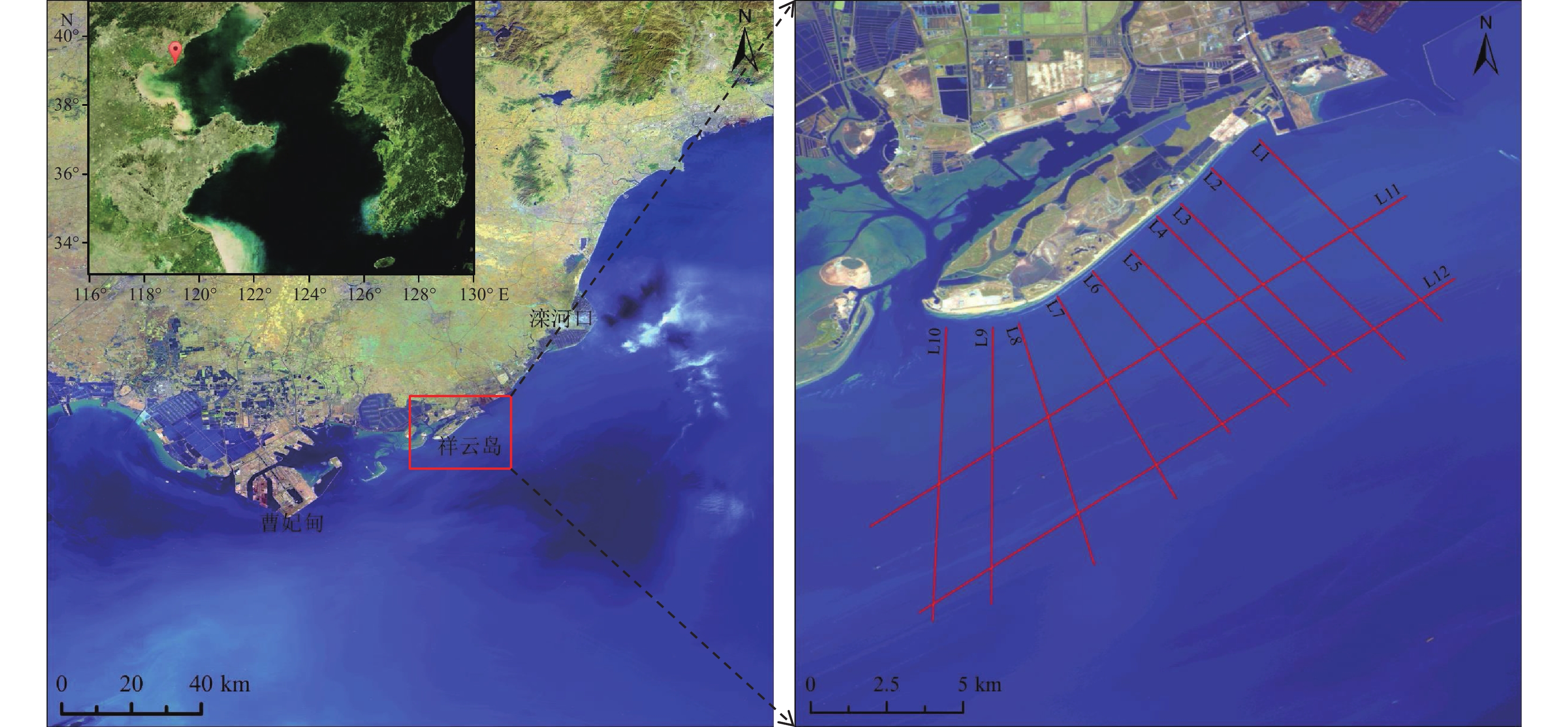
 下载:
下载:

